The Philippines Navy
 About 61 ships 1946-1991
About 61 ships 1946-1991
The Philippines were part of the non-aligned countries during the cold war, their independence gained in June 1898, but for long a status of US protectorate with limited capabilities. The archipelago really gained full independence from the US in July 1946. On May 12, 1964 under President Diosdado Macapagal the independence date was pushed back to 1898. The country gradually, notably due to an agreement with the USN to benefit from a naval and air base at Subic Bay, saw many vessels transferres via MDAP, notably suruplus WW2 stocks, but none larger than a destroyer escort. Its long history started in around 900 AD, until the Spanish Colonial Era from the 15th century, up to the 1898 Spanish-American war, the revolutionary and constabulary navy, the small OPV that fought a maritime guerilla war until 1945, and the cold war Philippine Navy created from scratch after the “second independence” in 1946. A force largely made of destroyers escorts, frigates, corvettes and patrol crafts, but with a sizeable amphibious force to act on a 115,800 square miles archipelago and a 14,000 miles coastline.
Early Beginning: Filipino naval Warfare
The Philippines had long been a seafaring nation. Early Filipino inhabitants came from across the seas – from Ancient China, Borneo and Malay Peninsula. For centuries, seafaring natives living along the coastal areas of the country have sailed across the uncharted waters of the surrounding seas in their frail little boats. The Filipino seafarers engaged in a very active trade and made regular voyages to neighboring countries in Southeast Asia and the Far East. During the Spanish regime, Filipino sailors have also been utilized by the Spaniards on their local expeditions and fights against their enemies.
Pre-colonial Filipino vessels
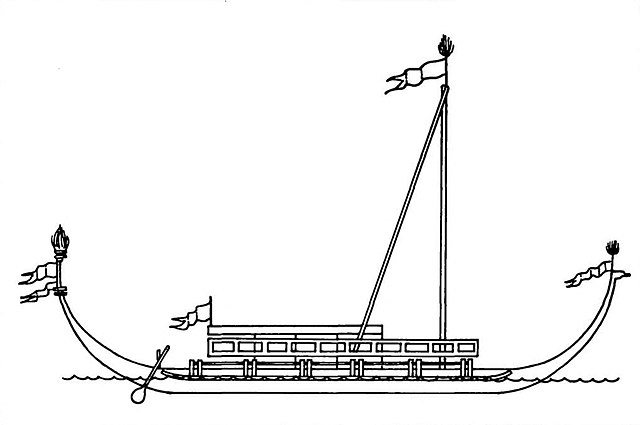
Visasayan Caracoa, the emblematic warship of the whole Philippines.
The ancient Philippines were already a hub of trade, commerce, communication, exploration, warfare and piracy between islands, generating a solid nautical culture. XVII to XVIIIth Cent. Western explorers already described a variety of local vessels, such as the balangay, an entire flotilla of which was discovered buried in the late 1970s in Butuan City. Other vessels typical of the region were the Karakoa or Korkoa, essentially very large catamarans with a central hull large enough to support a platform with another on top, loaded with javelineers and archers. Some were so large that the secondary hull had extra rowers, growing to a size of 25 meters and more, with a crew of about 120 including rowers and troops. Solidly built but without much protection from the elements or sails. They were purely made for one-day trips along the shores, taking refuge, dragged on land in case. They could be also completely disassembled and transported over land.
On the more general context, the history of the Philippines between 900 and 1565 (starts on 822 of the Hindu Saka calendar) the end of the “prehistory” of the Philippines, and archipelago home to numerous kingdoms and sultanates with influenced from the Indosphere and Sinosphere. After archeological finds, records from contact with the Song Dynasty and the Bruneian Empire, Korea, Japan, and Muslim traders helped tracing back some history. There was also records of local Muslim rulers later retook by Spanish chroniclers. About 20 kingdoms existed, some allied because of their common Muslim ruler, against coalitions.
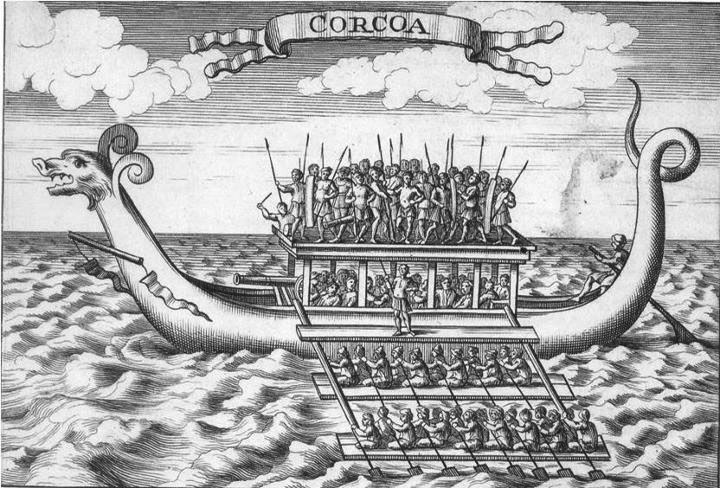
A spanish impression of the “Carcoa”
The achipelago was large enough to generate proper cultural traits and various regional dialects and languages. Maynila, Tondo, Namayan, Pangasinan, Cebu, Butuan, Maguindanao, Lanao, Sulu, and Ma-i were such kingdoms, ruled by a “Datus” over an autonomous groups called “barangay” or “dulohan”. The latter could form larger alliances leading sometimes to the “paramount datu”, equivalent to a rajah or sultan at the head of a small state. However development was slow due to the jungle conditions with appertn limited large-scale violence due to a generally low population density. Inside these Batangay existed a classic social structure between the nobility, Timawa “freemen”, dependent debtor-bondsmen also called as Alipin, either namamahay (serfs) or saguiguilid (slaves). As part of the Nobility there was the higher one (Datu), and the Maginoo, lesser noble class, supporting a Maharlika (Warrior class). Datu frequently rose from the Maginoo, and a reputed warrior could become a Maginoo, ensuring social elevation.
Trade with China under the Tang dynasty grew during the Song with some Philippine “polities” (small states) sending trade delegations as part of a Tributary system. Filipino impport products were jars, metal, salt and tobacco exchanged for feathers, rhino horns, hornbill beaks, beeswax, bird’s-nests, resin, and rattan. This of course draw piracy from smaller Polities and independent communites throughout the archipelago and drew probably either the Chinese to send armed Junks to carry the goods, or the most involved kingdoms to built mixes vessels for trade, but well protected.
Later a new trade developed with the Muslim world: Muslim traders introduced Islam to the Indianised Malayan empires Majapahit and already Makhdum Karim brought by 1380 Islam in its kingdom, establishing the Sheik Karimal Makdum Mosque in Simunul (Tawi-Tawi). Next came the Sulu Archipelago. It was frequent to see Arab, Malay and Javanese missionaries spreading the new religion.
The Sultanate of Sulu was once partly also over Malaysia in addition to the Philippines and a very well organized army and navy.
The centperpiece of these early fleets were composed on a very large, heavily ornamented Labong, supported by Karakoa and themselves by Balangay (a very common medium sized lashed-lug outrigger vessel), they could have comprised allied Moluccan Korakora, but for the long trips stuck to large “cruisers”, the two-masted, two stage Lanongs, the Banguingin Garay, and some Jong, from Java, which at the time was the most common cargo vessel for long trips. There was a military equivalent called the Borobudur (from the location a bas relief was found), another outrigger large vessel, which could have influenced the Karakoa. To communicate to the shore, the small Paraw were used.
Smaller fleets were called “abay”, comprising often one or two Karakoa and their supporting vessels, preceded by a fast scout ship, the dulawan or “lampitaw”. Ship-to-ship battles were called “bangga” and pursuit “banggal”. Enemy ships were captured whenever possible and it was usual to see a victorious Abay returning with twice as much vessels.
The largest pre-colonial naval battle was probably the “Battle of Manila” (the city was quite small at the time) in 1365 between the Luzon Kingdom and the Empire of Majapahit.
Warriors aboard karakoas used removable panels of bamboo or woven nipa, and fought with their own kalasag shield. They were proficient with javelins (Sugob) with sharpened bamboo, often poisoned, and carried swords such as the kalis or the bangkaw spear. The upper gallery contained archers using the pana or busog short range bow, used even in close quarters. With the introduction of gunpowder, before the Spaniards arrived it was common that Filipino warships were armed with several bronze or brass swivel guns (“lantaka”). One of these tribal nation called the Visayas were particularly fond of these expeditions, having these raids permanently tattoed. They were called the pintados (“the painted ones”) by the Spanish.
Spanish Colonisation
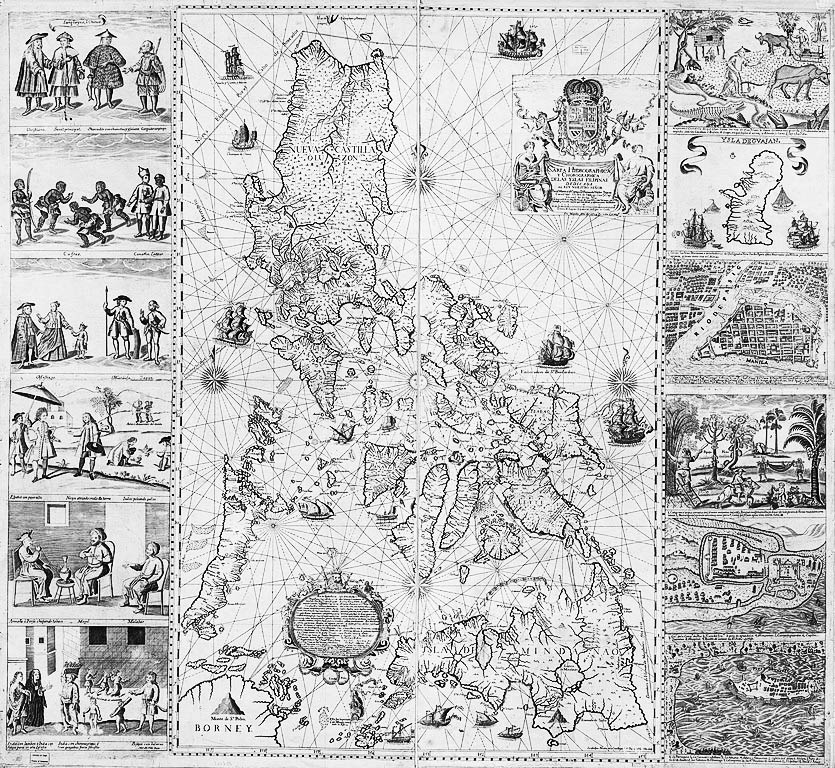
But the biggest theat to Filipino thalassocracies, which led seasonal maritime expeditions for prestige, plunder, and trading slaves or hostages, started with the Spanish Expeditions. The first was an exploration raid without much consequence by Ferdinand Magellan in 1521, followed by García Jofre de Loaísa in 1925, Álvaro de Saavedra Cerón (1527). There was nothing before Ruy López de Villalobos (1542) which started to erect small camps in Samar, Leyte and Saranggani, followed by the first colonies by Miguel López de Legazpi from 1564. From there, Spanish presence only grew up, until a full colonisation when Philip II became King of Spain on January 16, 1556 ordering “to discover the islands of the west”, but ordering a full conquest. An entire armada landed here Conquistarores, cavalry and artillery as well as craftsmen and everything needed to start a city, which became Manila.
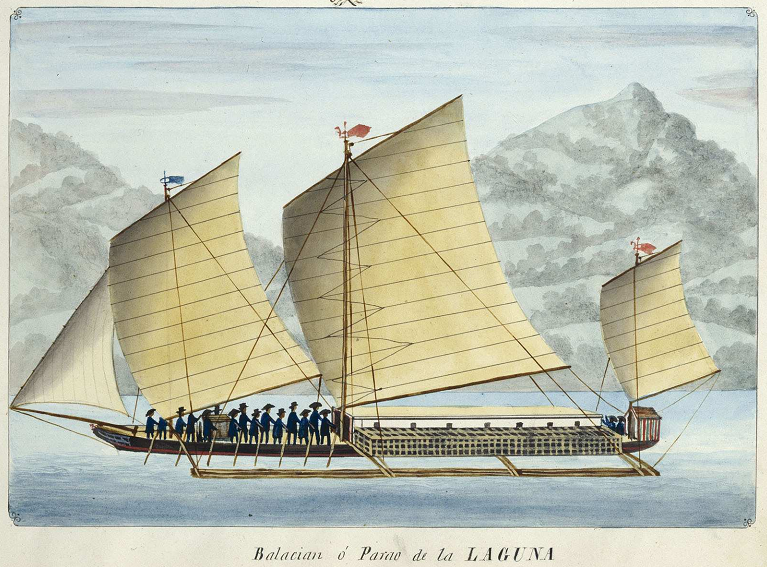
A Balacion Parao in 1847
With the tornaviaje return route to Mexico across the Pacific by Andrés de Urdaneta started the “Manila galleon trade”, for 2.5 centuries making Spain wealthy. Manila was in fact the first real city in the whole archipelago elaborated on European plans. As long as this expansion was noticed, the local bands tasked to exploring the islands tried to implement the same method as during the conquest of the Americas, along the “divide et impera” principle. Allied were seeked for, conquistadors taking part in regular raids, until the archipelago was entirely claimed and the authority settled. The scale of it however was such authority was never fully implemented. Some Islands like Palawan were simply too remote and impassable to be colonized. The greatest concentration was done on Luzon, called “Nueva Castilla”.
The Spaniards however were not alone in the region and in the 17th Century, clashes became more frequent against Dutch and British forces. To spice up the situation, tribal rebellions were quite common as well. The Spaniards though, were short of war vessels in the region, with only a few Galleons passing by. They started to rely heavily on local vessels, and in particular were impressed by the Karacoa (named “Carcoa”), they abundently used. The largest were made for a hundred rowers on each side, locals, with Spanish armed troops with muskets taking place in the center. They kept a lantaka (gun) at the front and another at the stern, and it’s possible the Spaniards added to these a few pintle-mounted arquebus. For trade withing the archipelago, praos were used. Pure civilian vessels, they had double sails, quite tall.
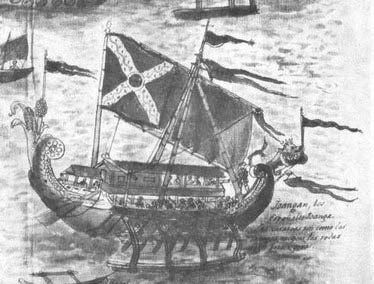
A Filipino-Spanish Joangan
One of the largest naval battles with the natives was the Battle of Bangkusay on June 3, 1571, over the control of the Pasig River Delta, against the Rajahnate of Maynila and Tondo. Tarik Sulayman launched a fleet in the Bangkusay Channel on Spanish forces (Miguel López de Legazpi) but was completely defeated. When control was effective, local Spanish naval forces started policing the seas and provided naval logistics to the Army. All rebellions were quelled by small groups of conquistadors backed with native auxiliaries on local ships, most often Joangas. Galleons were just too precious for these actions. Joangas or juangas were a mix of construction techniques and could be decribed best as an hybrid between a Carcoa and a Spanish pinnace. They were strongly built, had imposing rigging and many guns. These expeditions were completed by brigantines, galleys and support vessels.

Reception of the Manila Galleon by Chamorro in the Ladrones Islands, 1590
As for the “Manila galleon”, when not used to carry the goods, they protected the archipelago from foreign invaders, the better equipped British and Dutch traders. Filipinos made the crew, framed by Spanish officers or mulattoes. Two famous Manila Galleons were “Encarnacion” and “Rosario”, hastily converted by the local governor tp meet a Dutch armada of 18 vessels (battles of Manila, 1646). Five naval battles this year took place on the “Spanish East Indies” and the Dutch Republic was repelled, which was considered important in the general context of the Eighty Year’s War. The Spaniards only had at the end three Manila galleons, a galley and four brigantines, but they had reinforcements from local auxiliariy vessels.
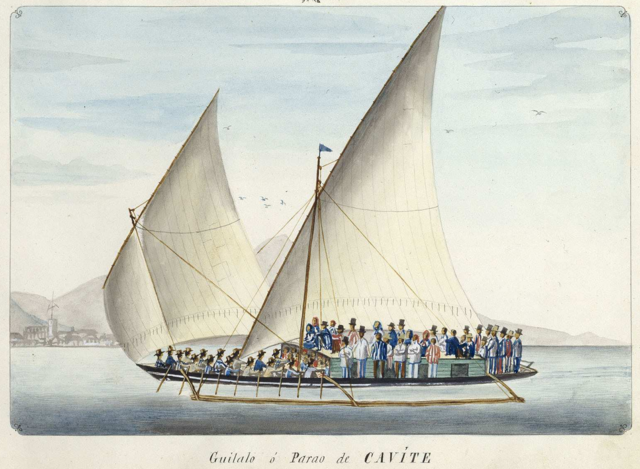
A Guilalo Parao in Cavite, 1847
Fast forward to the XIXth Century, and the Philippines were still an important part of the Spanish Empire, despite the lack of funds to properly maintain a navy. Indeed in the 1860s efforts concentrated of building a fleet of modern ironclads to defend the homeland, while these were gunboats the real bulk of colonial presence, with occasional sailing cruisers or frigates. I will not dive into the Spanish fleet in 1898, this is the object of this article. The war of course marked a true rupture for the Philippines, ending a long colonial rule.
Revolutionary and Constabulary fleets
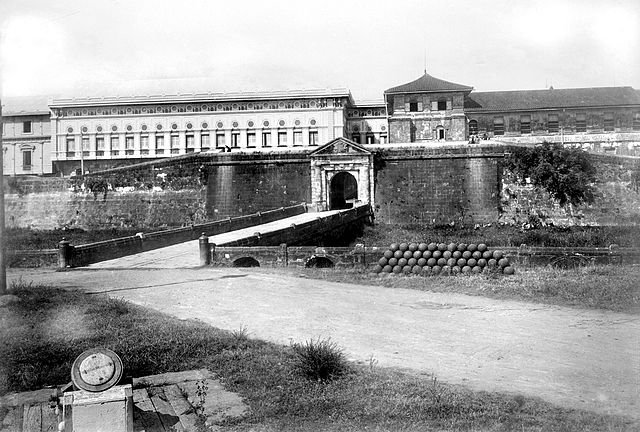
A view of “old Manila” or the walled intra muros, Santa Lucia Gate in 1898.
The official start date for the Philippines Navy was June 1898. Indeed, before independence was proclaimed, the Philippine Revolution began in 1896, with a Pact of Biak-na-Bato, a truce signed on 14, 1897, while Emilio Aguinaldo and others taking refuge in Hong Kong. Revolutionaries used a variety of local vessels to mount attacks against isolated garrisons. The Spanish–American War saw Commodore George Dewey arriving from Hong Kong to defeat on May 1, 1898 the Manila Bay Spanish Armada. Dewey later transported Aguinaldo back to the Philippines (May 19, 1898), having a meeting in Cavite and starting negociating independence terms with the American Force, making a proclamation on June 12, 1898 in presence of a retired American artillery officer, Colonel L. M. Johnson. The Philippine flag was raised for the first time.
Before that, on May 1, 1898, after the battle, Admiral George Dewey granted the Revolutionary Navy a small pinnace “Reina Cristina”, formerly used by Admiral Patricio Montojo, renamed Magdalo. But the Navy was really formally established during the second phase of the Philippine Revolution, the “Revolutionary Navy” revolving around eight captured Spanish steam launches refitted with 90 mm guns. Leon Apacible, Manuel Lopez and Gliceria Marella de Villavicencio were followed by Taaleño, Balayan, Bulusan, Taal and Purísima Concepción. Compania de Filipinas (flagship) was a 900 ton vessel, at the head of the vessels seen already, added to a few steam launches purchased from China and donations from patriots.
Bases were the Ports of Aparri, Legazpi, Balayan, Calapan, San Roque, Cavite, and Captain Pascual Ledesma became the first Director of the Bureau of the Navy, assisted by Captain Angel Pabie and the Malolos Constitution precised the Navy was to be transferred from the Ministry of Foreign Relations to the Department of War headed by General Mariano Trías. However the Spaniards made secret arrangements with a US delegate, and ceded the colony directly to the United States with the Treaty of Paris. The Philippines Revolutionary Government never recoignised it, trigerring the bitter Philippine–American War, the first US Colonial war, lasting until 1902 and costing 4,000 American soldiers versus 20,000 Filipino. The Philippine naval forces were decimated by this war. After this, the constabulary force still fought guerillas practically up to WWI.
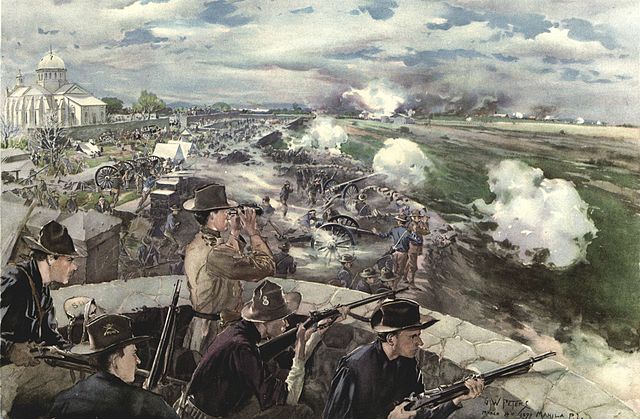
Battle before Caloocan in October 1899, Douglas McArthur is in command.
It’s the establishment of civil government by a Congress act that eased the tension by giving the Filipino representation, along a serie of reforms on education, transport and laws. The country modernized, but pre-independence guerrilla movements continued to act for years afterwards, clashing against the American Army or Philippine Constabulary patrols. This led to the “Insular Government” until 1935.
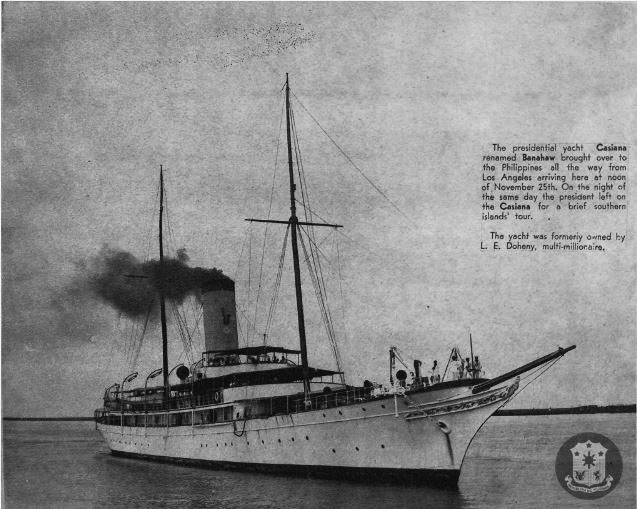
The Presidential Yacht BRP Panahaw, ex-Casania, Ex-Cassandra arrives in the Philippines, 25 November 1936
The local navy was the naval branch of the Philippine Constabulary, organized in 1901. It used a variety of small vessels, either steamers or some locally built. The first famous ship was Aguinaldo’s “fake cruiser”, a steamer with piping painted and maskeraded as guns, which was sufficient to deter to surrender a Spanish garrison in May 1898, but prevented to do more due to the presence of the German Cruiser Irene.
The Philipino-American war saw the Filipino forces using their traditional boats for quick raids on isolated outpots and use fluidity in their guerilla tactics. This brought them victories at Paye, Catubig, Makahambus, Pulang Lupa, Balangiga and Mabitac. Skirmishes between government troops and Guerillas lasted until 1913, with the Government troops at least equipped with steamers.
The Revolutionary Navy
As an island archipelago, the early Filipinos had realized that the Philippines is a maritime country. Its development and progress depended primarily on the sea and the sustaining trade and commerce not only with other countries but also with neighboring islands. The Filipino nationalist fighting against Spanish domination were fully aware of this as they underscored it as vital factor in their struggle for independence. The destruction of the Spanish Navy became a major component of their revolutionary undertaking.
The Philippine Revolutionary Navy of 1898 The history of the Philippine Navy traces its early beginnings during the later part of the Philippine Revolution in 1898. General Emilio Aguinaldo, leader of the revolution, organized the Navy in June 23, 1898 as he proclaimed a Philippine revolutionary government. Captain Pascual Ledesma, a merchant marine ship captain, was appointed as the Director of the Navy assisted by another merchant, marine ship captain, Captain Angel Pabie. The Navy was placed under the Department of War headed by General Mariano Trias responsible for naval operations in support of the land forces and the merchant marine.
The Revolutionary Navy was initially composed of a small fleet of eight Spanish steam launches captured from the Spaniards. Their rich owners – Leon Apacible, Manuel Lopez and Gliceria Marella de Villavicencio, later donated five othervessels of greater tonnage, the TAALENO, BALAYAN, BULUSAN, TAAL and the PURISIMA CONCEPCION. The 900-ton inter-island steamer further reinforced the fleet,
Compania de Filipinas (renamed Filipinas), steam launches purchased from China and other watercraft donated by wealthy patriots. Naval stations were later established in the ports of Aparri, Legaspi, Balayan, Calapan and San Roque, Cavite that served as ships’ home bases The Navy of General Aguinaldo’s revolutionary government bore the brunt of assisting ground operations and transporting Filipino troops and war materials to the different islands of the archipelago in support of the revolutionary cause.
When the revolution spread throughout southern, central and northern Luzon, TAALENO and DON FRANCISCO were the first naval boats used in the campaign. These boats led the first offensive along the Batangas line that contributed to the surrender of the Spaniards in Batangas. In one of its support operations, the naval ship, FILIPINAS, almost figured in an encounter with the German cruiser, Irene, which tried to protect the Spanish garrison in Subic. Successive victories of the revolutionaries in the North led further campaigns towards the south. Using Torrijos, Marinduque as a staging area for amphibious operations, the marines and reconnaissance divers trained by General Ananias Diokno were sent to liberate Bicol and the Visayas.
The Colonial Navy
The American colonial government created the Bureau of the Coast Guard and Transportation, established to transport Philippine Constabulary troops and performing usual coast guard tasks, policing the seas and shores, patrols against smugglers and pirates. Filipino sailors were used both on ships and the administration as well as in the Bureau of Customs and Immigration and of Transportation as well as the Coast and Geodetic Survey. They also manned Lighthouses. The old Spanish colonial Escuela Nautica de Manila became the Philippine Nautical School modelled after USN Annapolis Academic principles and organization. The first breveted Filipino midshipman was accepted in 1919 and Filipino were free to enlist in the U.S. Navy.
In 1917 the Philippine Assembly created the Philippine National Guard joining the American Expeditionary Force, but absorbed into the National Army and never seeing action. All this time, Manila was modernized and enhanced with new drydocks, storage areas, better connectivity hubs and development of the train, and became a semi-permanent base of the US Pacific Squadron, which composition was highly volatile over the years. It was reduced in 1917 to answer the call in the Atlantic, and was merely counting permanent gunboats.
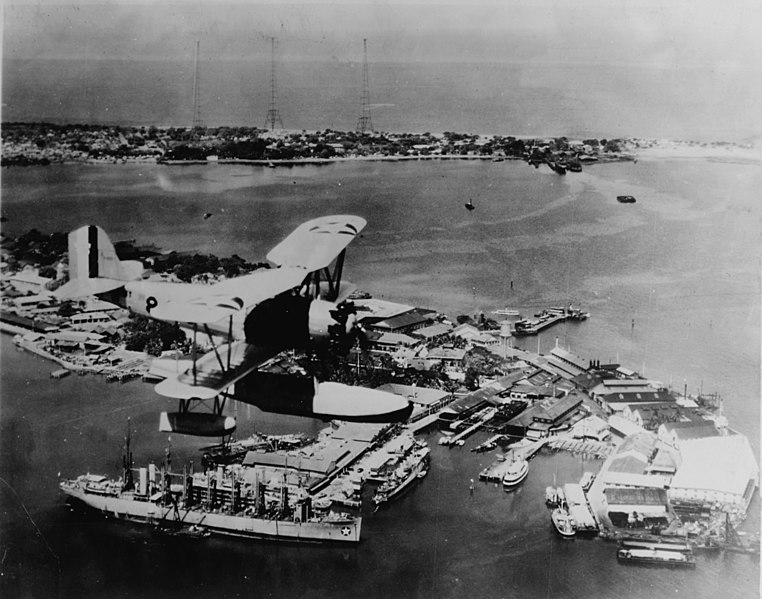
A Vought O2U over Cavite Yard (a fleet coaler similar to USS Langley is visible), 1930.
The interwar years saw a rapid increase of the development of coastal fortifications, chief of which was the formidable Battery of Fort Drum on the island of El Fraile, also called the “concrete battleship”. This was in large part the work of McArthur, which for all his years there cemented a strong bond with the natives. The paradox was that he was appointed on December 20, 1900, to replace the more lenient Elwell Otis as U.S. Military Governor, placing the country under martial law to deal with the Guerillas. The Spanish Civil War (1936–1939) saw an influx of Filipino volunteers fighting on both sides in the war. Many filipino served on US ships which were permanently part of the Manila Squadron.
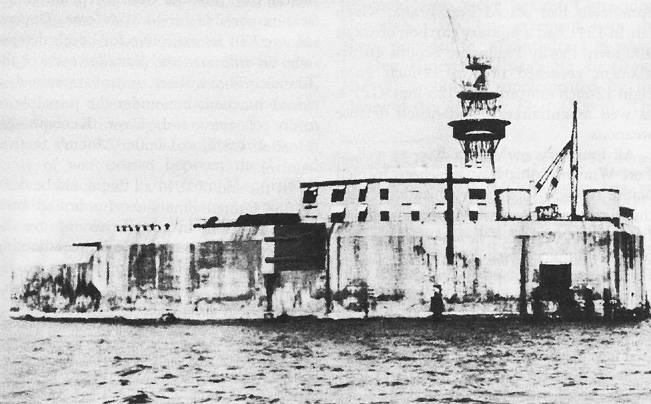
Fort Drum, the “concrete battleship”, part of the network of fortifications and batteries protecting the approaches of the Bay of Manila.
Later better autonomy came with the establishment of the Philippine Commonwealth (1935–1946) with Manuel L. Quezon, president of the Senate of the Philippines elected as first president of the Philippines. This was seen as an effort towards a peaceful transition to full independence, better autonomy granted in step, but this was all stopped by the Japanese invasion, making the true independence reported to June 1946 instead.
The Off Shore Patrol (OSP):
During the Philippine Commonwealth under President Manuel L Quezon, the Filipino Navy existed as adjunct to the United States Armed Forces. Filipinos served the US military service. With the creation of a separate Philippine armed force, a naval organization was formed as a seagoing arm of the Philippine Army. On 09 February 1939, the Off Shore Patrol (OSP) was organized with headquarters located at Muelle Del Codo, Port Area, and Manila. It was headed by 1st Lt. JOSE V ANDRADA, a graduate of the US Naval Academy in Annapolis, Maryland.
Initially, the OSP was assigned with three US Navy Motor Torpedo Boats and christened as follows:
1. Luzon (Q-111) 83-footer
2. Abra (Q-112) – 65-footer
3. Agusan (Q-113) – 65-footer
On 09 January 1941, the OSP Training School was organized with CAPT. MARCELO S. CASTELO as its first Commandant. It offered courses in torpedoes, depth charges, communications, seamanship, engineering andoperations of gasoline engines in consonance with the characteristics and capabilities of the Q-Boats. During World War II, however, Japanese planes bombed the OSP Headquarters on 23 December 1941. The Base Commander burned the base before Japanese troops entered Manila.
WW2 Operations
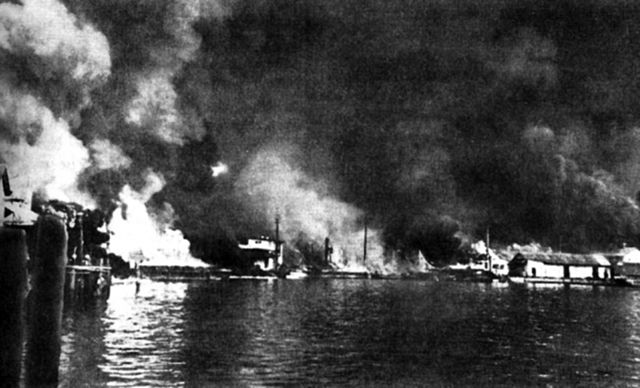
Sangley Point Cavite Navy Yard burning after a Japanese air attack on December 10, 1941. Small-arms shells explode (left) and a torpedo-loaded barge (center) burns.
The Japanese decided not to attack via the bay of Manila but landed north and progressed to the south. The costly fortifications were eventually captured, least of which was Corregidor. Many USN vessels present at the time in December 1941 were manned by Filipino crews, with the same level as US sailors. Cutters and Coast Guard steamers, requsutioned patrol vessels, but nothing of the size of a destroyer. Many Filipino were also out at sea on other vessels. The first Filipino military casualty was an RAF voluntary aviator, First Officer Isidro Juan Paredes in November 1941 at RAF Burtonwood. US Forces and Filipino fought in the Japanese invasion of Batan Island, Vigan, Aparri, Legazpi, Lingayen Gulf, Lamon Bay, Bataan and Corregidor. The USN in the Philippines was not impressive, resting due to administrative reasons solely on the United States Asiatic Fleet. The Commonwealth navy was virtually discarded.
The latter comprised moslty defensive submarines. The bulk of the Pacific Fleet was stationed in Pearl Harbor. On 25 July 1939, Admiral Thomas C. Hart was in charge, based in Cavite Naval Base and Olongapo Naval Station, Luzon. The HQ was located at the Marsman Building in Manila. On 22 July 1941, the Mariveles Naval Base at least was setup to serve the Asiatic Fleet. Hart had at its disposal only a number or submarines under command of COMSUBAF Captain John E. Wilkes: And these were old S-class mpdels, assisted by the submarine tender USS Canopus, completed by some of the Porpoise class, called Submarine Squadron 5.
At last this was reinforced in October 1941, with 12 Salmon/Sargo class delivered in addition (under command of Stuart “Sunshine” Murray) SubDiv 15, and Captain Joseph A. Connolly’s SubDiv 16 assisted by the tender USS Holland. Hart’s plan in case of a Japanese attack relied on these submarines for deterrence. However he was later wildly critized: No defensive minefields were laid, peacetime training was inadequate and defensive plans ner to non-existant. There were poor deployments in the first hours, while the submarines were doomed by their defective torpedoes. Lingayen Gulf was free for the Japanese, unexpected spot for a landing. Several S types subs managed however to score some kills.
The Philippines, without significant naval forces after the Asiatic Fleet was withrawn, following Pearl Harbor was down to its Offshore Patrol (OSP) Force (HQ Muelle Del Codo, Manila): Five high-speed Thornycroft 55-ft CMBs and a few 65-ft PT boats. Since 1935 and new adùinistrative arangement, here’s what McArthur had to say about this:
“A relatively small fleet of such vessels, …will have distinct effect in compelling any hostile force to approach cautiously and by small detachments.”
He stayed as a Military Advisor to the Philippines regarding the OSP PT boats.
Despite all odds, the latter fought with courage, even heroism, performing countless raids on IJN ship concentration. The “Mosquito Fleet” pioneered the use of PT boats in the Pacific, no less. They showed their capabilities, attacking by surprise, by night and withdrawing after inflicting crippling losses. It was cited for gallantry when shooting down by daylight nine Japanese dive bombers on their way to strike Bataan. They did their share also in the evacuation of top Philippine and U.S. officials to Corregidor. Surviving personnel after April 9, 1942 were part of the newly formed guerrilla where were found a part of the former Philippine Commonwealth Army. They performed hit-and-run attacks until the landings of late 1944 with 66 recipients of the Silver Star Medal and others. Virtually eliminated, the Filipino Navy was rebuilt from scratch in the postwar years.
Birth of the modern Filipino Navy in 1946
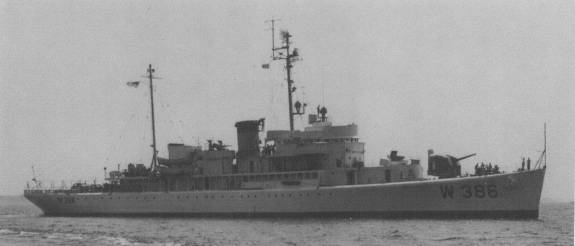
BNP Georgio de Pilar. A Barnegat-class seaplane tender converted during construction into a motor torpedo boat tender as USS Wachapreague (AGP-8), with a rich WW2 career in the pacific, was in service post-war with the US Coast Guard as USCGC Mc Culloch, and then with the South Vietnamese Navy as Ngo Kuyen before being retransferred to the Philippines Navy as Georgio de Pilar. She is assimilated to the Casco class cutter but was classed as a frigate.
The Philippine Naval Patrol (PNP):
The Off Shore Patrol was reactivated on 01 October 1945, just after World War II. The OSP Training School was transferred to Cavite Naval Shipyard and renamed OSP Training Center; The OSP was further expanded and became a major unit of the Philippine Armed Forces. On 04 October 1947, the OSP was renamed Philippine Naval Patrol (PNP) during the time of President Manuel Roxas. On 05 January 1951, the PNP was further designated as the Philippine Navy Src
In 1945 the OSP was reactivated (and led) by Major Jose Andrada, and all he had was a core of surviving OSP veterans, which had the task of training new recruits. It was strengthened in 1947 when President Manuel Roxas issued Executive Order No. 94 to a major command equal with the Philippine Army. It became one of the fout branches with the Constabulary and the newly formed Philippines Air Force. Enters the “Philippine Naval Patrol” and eventually the “Philippine Navy” by January 1951 with again, Jose Andrada as Commodore. This was was to be composed of all naval and marine forces which included support, logistic units, shore installations, Marines and Air Forces. The same year indeed the Filipino naval aviation was created and became much later the “Naval Air Group”.
The Philippine Navy in Action and important dates
The Philippine Navy participated in the Korean War, between Combat Service Support, and escort.
In January 1958, the Navy conducted a first US-Philippine naval exercise (Operation “Bulwark One”), for harbor defense with a Philippine naval officer as overall commander.
The 1960s had the Philippine Navy certainly the best equipped in Southeast Asia.
In 1967, maritime law enforcement went to the Philippine Coast Guard until 1988 and independet afterwards, as part of the Department of Transportation.
The PN also took part in the Vietnam War with a Philippine Contingent.
Communist insurgency led to further extension of the Philippine Army and, Air Force in support of naval operations whuich carried troops and provided naval gunfire support.
The end of the cold war started a wave of question about the presence of such large US military bases in the country. Mount Pinatubo in 1991 had Clark Air Base was abandoned, but not because of the volcano but mainly due to the Senate terminated the treaty for the very large Subic Naval Complex in Zambales. President Corazon Aquino called a national referendum to combat also the end of the eceonomical influx, but again it was rejected. This ends a long relation in the context of Chinese PLAN massive extension in the south china sea.
US Presence in the Philippines: Subic Base
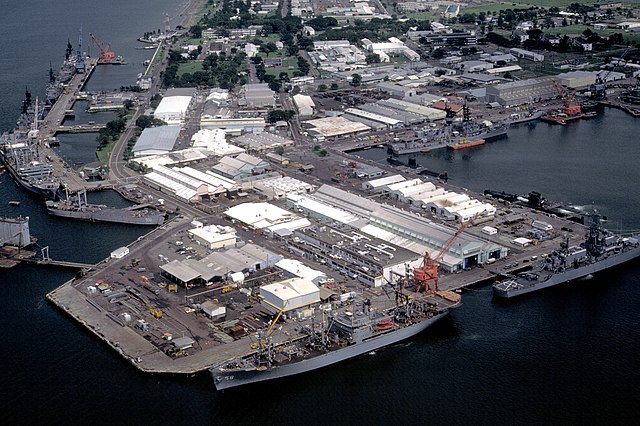
Ships docked at the US Naval Station Subic Bay Philippines on 28 August 1981
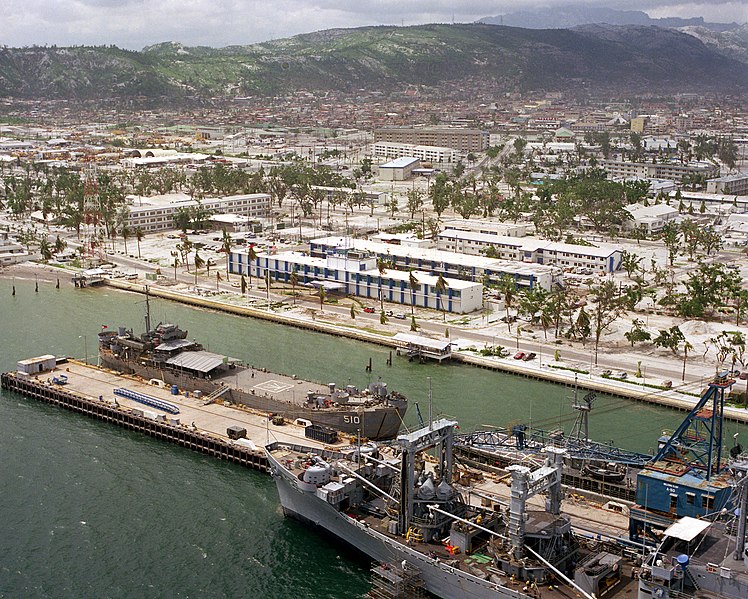
USS Haleakala (AE-25) at Subic Bay, 1991
Naval Base Subic Bay during the US military presence in the Philippines. It had been already developed as such to USN standards duting the interwar, and originally a former Spanish facility attributed by the 1898 Treaty Of Paris, strategically located. Indeed, the bay and its sheltered anchorages, deep water were noted already by Spanish explorer Juan de Salcedo. It was further surveyed in 1868 to determine its conversion as a naval base by the Spanish Authorities, and despite some resistance from Manila, in 1884, a Royal Decree declared Subic Bay as a naval port. Construction work started on a grand scale and were completed in 1884 when it opened, but further improvements were made until the war. https://en.wikipedia.org/wiki/U.S._Naval_Base_Subic_Bay
The closure of Naval Base Subic Bay in 1991-92 (between decision and effective closure) which had provided for decades to the USN the only ship-repair, supply, rest and recreation facility in the area was prompted by both political (Philipino politics) and geological (Pinatubo eruption) unrest. It was at some time the second largest overseas military installation, and playing a key role in the Pacific Campaign, but also in the Korean, Vietnam wars, even Operation Desert Storm. The departure of President Ferdinand Marcos and the People Power Revolution saw a rise in nationalism playing on a general dislike of the US presence on the opinion.
June 15, 1991 only doused gasoline on this small fire: The eruption of Mount Pinatubo, second-largest eruption of the century, causing untold devastation. The US Clark Aibase was evacuated and closed down as well as Subic Bay. But unlike the airbase, it was less badly damaged: Operations were able to resume quickly. However on September 13, 1991 the Filipino Senate seeing the end of the lease, rejected an extension. This put an en on American military presence in this region, causing the relocations of 5,800 military personnel but also 600 civilians and ten times more military dependents. This was also a major economic loss for the region. Its strategic value for the US chessboard was invaluable, and is more so today with the rapid rise of Chinese sea, land and air power in the region.
The Philippines Marines
Secretary of Defense Ramon Magsaysay in 1950 had the idea of creating a marine battalion specialized to carry out amphibious missions. Largely inspired by the Spanish and later US Marines example of WW2, it was created for a precise purpose: To deal against the Communist Hukbalahap movement.
The Philippine Marine were created under President Elpidio Quirino on November 7, 1950, as the 1st Marine Battalion, HQ Naval Base Cavite. They were formed by personal detached long-term from the US Army/USMC for training on a whole panel of combat and amphibious missions from Fort Bonifacio, Makati. Lieutenant Senior Grade Manuel Gomez too command first, assisted by a Lieutenant Junior Grade commander and six other officers, two coming from the Philippine Army for liaison. Most were WW2 vets. The 1st brigade created landed on April 19, 1951, in Umiray, Quezon, defeating on June 4 in Nueva Ecija the communist rebels. It was also deployed in Korea, and soon was joined by B company in 1955 tp form the 1st Marine Battalion. Each comprises a HQ company, two marine rifle companies.
In the 1960s, this was expanded, with a better esprit de corps and its own drum and bugle corps. They saw action in the Spratly Islands in 1971 and the 2nd and 3rd Marine Batallion operated with the 1st Provisional Tactical Battalion in Mindanao against Islamic separatists and from 1976 the “Philippine Marines”. The 1980s saw a flurry of deployments against communists and Islamist rebels. In 1986 the Marines part in the People Power Revolution. They took part in the coup d’état toppling Corazon Aquino, but failed. Rodolfo Biazon became its first general and by the 1990s the corps was renamed again the “Philippine Marine Corps” due to its extension to four brigades:
The 1st, 2nd, 3rd, 4th manoeuver Marine Brigades, joint to a Combat Service and Support Brigade (CSSB), Coastal Defense Regiment (CDR) and independent units: Marine Special Operations Group (MARSOG), Marine Security and Escort Group (MSEG). The CSSB is the training and administrative command for the Field Artillery and Assault Armor battalions.
The corps comprised 12 Marine Rifle Battalions, with three are assigned per maneuver brigades, single battalions being rotated to the Marine headquarters for refit and retraining for six months every year before redeployment in the southern Philippines.
Each rifle bat. comprised three rifle companies and one HQ/service company. Other units are joint for mission-based organization like the artillery, armor and special watercraft, supported by the CSSB. Once contituted, this becoms a Marine Battalion Landing Team (MBLT), to which can be attached a combat engineer unit (NCEBde) or elements of spec-ops (MARSOG).
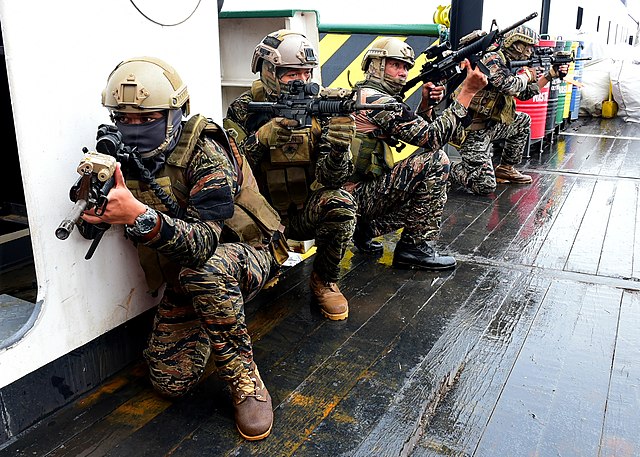
The 7th Marine Brigade is a Reserve one, a provisional activated on October 22, 1996, assigned to the Naval Reserve Command, with 3 operational Marine Battalions, and full interoperability with the rest of the Corps, under the Naval Reserve Command (NRC). Among the units that can be added to a MBLT, is the Field Artillery Battalion (FABN) comprising a Headquarters and Service Company, with several howitzer batteries equipped with the M101A1 howitzer, OTO Melara Model 56/14 pack howitzer, Soltam M71A1 155 howitzer. Organic support comprised several Bofors 40 mm L/60 guns batteries as well as twin Oerlikon 20mm guns M2 on M35 trucks, or towed.
The Assault Armor Battalion is the main mobile “teeth” also to be joined in operations to a manoeuver brigade: It comprises:
-The Headquarters and Service Company
-Armor Maintenance Company
-Assault Amphibian Company
-Light Armor Vehicle Company.
Armored assets comprised manly the light/wheeled LAV-150, LAV-300, and for amphibious assaults, the LVTP-5s, LVTH-6s, and AAV7A1. LVTP-5s were retired at the end of the cold war while four LVTH-6s were reconditioned (providing howitzer support).
On August 19, 1972 was formed the Marine Special Operations Group, later renamed the Marine Force Recon Battalion:
-Headquarters
-Service and Training Company
-Four Recon Companies 61st, 62nd, 63rd, 64th.
Each of is attached to a Marine Brigade as quick maneuvering force, sea, air and land operations like the specops or Naval Special Operations Command?
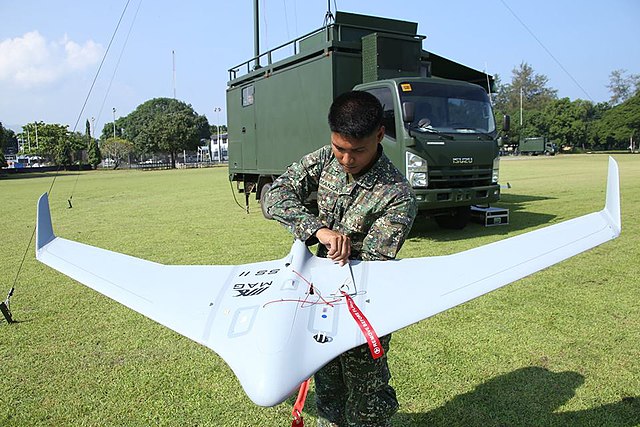
Philippines Marines IIMIT SS-1 UAV ready for deplyoment
The Marine Security and Escort Group:
The MSEG is a security unit on naval facilities, vital government installations and VIP protection, ceremonial duties, honor guard. They can be seen in faction notably at the Rizal Monument in Manila. This is completed by the Marine Drum and Bugle Team, Marine Scout Snipers, Philippine Marine Corps Marine Silent Drill Platoon (HQ Makati), premier military drill team, with 4 units modelled after the USMC “Silent Drill Platoon”.
Marine Bases comprised the barrack at Rudiardo Brown (Marine Base Manila) and Fort Bonifacio, Taguig City, Gregorio Lim at Ternate, Cavite, Arturo Asuncion at Zamboanga City, Domingo Deluana in Tawi-Tawi and Teodulfo Bautista, Jolo, Sulu.
The Philippines Naval Air Service
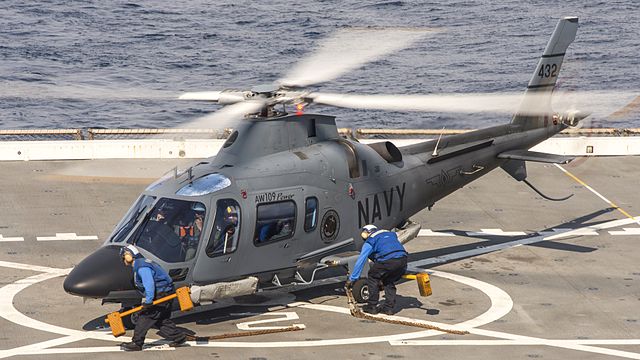
Philipino AW109 in flight operations landing on USS Green Bay
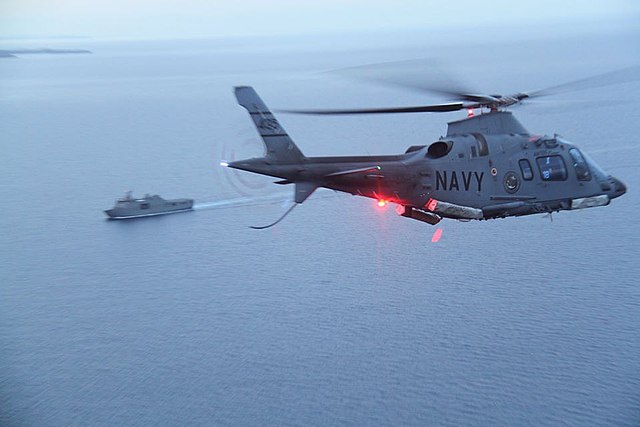
AW109E helicopter on a Tarlac class LPD
This corps tasked fropm naval reconnaissance and maritime patorl, SAR, and ASW tasks comprises three units:
-30th Naval Fixed Wing (31st Light Utility Patrol Squadron + 32nd Maritime Patrol & Reconnaissance Squadron)
-40th Naval Helicopter AG (41st Maritime Strike and 42nd ASW Helicopter Squadrons)
-71st Maritime Unmanned Aerial Reconnaissance Squadron
Today’s Naval Air Wing comprised 33 models, including 25 aircraft, 8 UAVs, providing Maritime reconnaissance and support. HQ Danilo Atienza Air Base, Cavite City.
The 32nd Maritime Patrol and Reconnaissance Squadron operated the twin-engine Beechcraft King Air C-90
The Naval Aviation Squadron MF-30 is equipped with the twin-engine BN-2A Islander
The Naval Aviation Squadron MH-40 is equippeed with the helicopters Leonardo AW159 Wildcat, Agusta-Westland AW109E Power, and the German MBB Bo 105C.
The 71st Maritime Unmanned Aerial Reconnaissance Squadron operated Boeing Insitu ScanEagle UAVs
The Naval Air School Center NATS-50 operated the small training Cessna Skyhawk 172M and Robinson R22 Beta II.
The Philippine Navy Organization
Almost since the start, the Navy is administered through the Department of National Defense, headed by the Chairman of the Joint Chiefs of Staff which is a four-star admiral and most senior military officer. Second is the Chief of the Navy, a vice admiral, solely responsible for the administration and operational status, the equivalent of the US Chief of Naval Operations (CNO)
It was divided in the 1970s into the Philippine Fleet and the Philippine Marine Corps, refined further into seven naval operational commands: Five naval support commands, seven naval support units, largely depending on finding the best suited locations for a local quick response.
The Philippine Fleet’s Commander-in-Chief was for long under command of Ferdinand Emmanuel Edralin Marcos Sr. from 1965 to 19985. Under him is the Secretary of National Defense, a Senior Undersecretary, the National Security Adviser (Secretary), the Presidential Adviser for Military Affairs (Secretary), the Chief of Staff of the Armed Forces (a Lieutenant General), and the Flag Officer-in-Command of the Navy, a Vice Admiral.
In USN parlance, the Philippine Fleet is acronymized as a PHILFLEET (and simply “PF”), and comprising the following:
-Offshore Combat Force (OCF): Offshore patrol and combat, territorial defense
-Littoral Combat Force (LCF): for the overall coastal defense and littoral patrol
-Sealift Amphibious Force (SAF): Naval sealift, transport and amphibious deployment
-Naval Meteorological and Oceanographic Center (NMOC/NAVMETOC): maritime and meteorological research, hydrographical surveys
-Fleet Support Group (FSG): Support, supply, repair.
-Naval Air Wing (NAW): Aerial reconnaissance, maritime patrol, air support, onboard ASW operations.
-Submarine Group (SG): Submarine force and underwater operations.
-Fleet Training and Doctrines Center (FTDC): Overall training, naval college, academy and advanced branches like the staff-related doctrine development
-Philippine Marine Corps (PMC): Combined arms corps with the amphibious landing forces.
-Naval Special Operations Command (NAVSOCOM): Philippines special operations units, separated from the Philippine Fleet as of 2020.
Naval Command
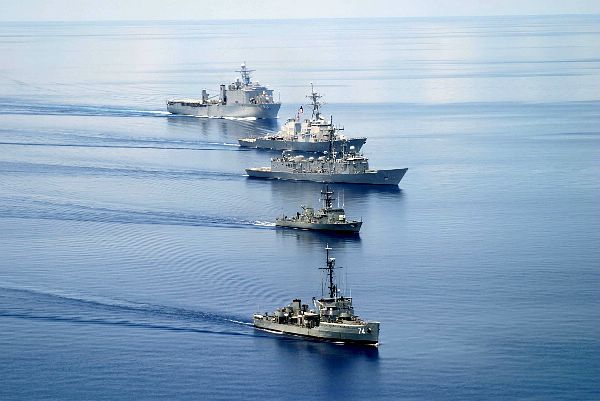
PS-35 training with the USN
The Naval Operation Commands is split today between seven regional commands, but earlier it was five.
-Naval Forces Northern Luzon (NAVFORNOL)
-Naval Forces Southern Luzon (NAVFORSOL)
-Naval Forces West (NAVFORWEST)
-Naval Forces Central (NAVFORCEN)
-Naval Forces Western Mindanao (NAVFORWESM)
-Naval Forces Eastern Mindanao (NAVFOREASTM)
-Fleet Marine Ready Force
In addition the southern command was split in 2006 into the NAVFORWEM and NAVFOREM.
Naval Support Command
The Naval Support Commands operates the Fleet Support Group (FSG) in charge of supplying naval and maritime operations, and is split into five commands:
-Naval Sea Systems Command (NSSC)
-Naval Education and Training Command (NETC)
-Naval Reserve Command (NAVRESCOM)
-Naval Combat Engineer Brigade (NCEBde)
-Naval Installation Command (NIC)
Naval Sea Systems Command
The NSSC replaced the cold war Naval Support Command (NASCOM). It is in charge of quality control of supplies with civilian providers, and provides services to sustain any naval operations. This currently is the largest industrial complex of the Philippines Forces (all combined), from military shipyards. There is also a R&D antenna in charge of the adaptation and development of new technologies, but it is overall responsible of naval maintenance. Main base and HQ are in Muelle de Codo and Fort San Felipe (Cavite City).
Naval Education, Training and Doctrine Command
The NETDC is the main naval training and instruction institution, also responsible of naval careers. Its HQ is at NAS Leovigildo Gantioqui, San Antonio, Zambales.
Naval Reserve Command
Former cold war Home Defense Command, NAVRESCOM is in charge of all naval reservists, notably the Naval Reserve Officers Training Corps for midshipmen/women. In special cases it is in charge of recalling reservists for a rapid-on-demand expansion of the manpower. This had been used during rebellions and natural disasters such as the Pinatubo Eruption. HQ located at Fort Santiago, Manila.
Naval Combat Engineer Brigade
The NCEBde (Philipino Seabees) main tasks are combat engineering and amphibious construction for combined operations. They are responsible to ensure good mobility, assault, survivability and settling in ground combat and amphibious areas of operation. All are performed under combat conditions, and could also comprises repair, supply, but also harbor clearing and salvage works. It is also in charge of protecting naval garrisons on contested shoals and islands, which rose in importance recently in the South China Sea.
Naval Installation Command
The NIC was knwown in the cold war as “Naval Base Cavite”. It is tasked of harbour refueling, water supply, shore power connections, berthing, ferry service and tugs, sludge disposal or housing.
Naval Support Units
The Naval Support Units are in charge of the support of the navy logistics at sea, not in harbour. It is in charge of the personnel, financial, management and the civil-military relations, but also and health care, spread into nine sub-commands:
-Bonifacio Naval Station
-Civil Military Operations Group-Philippine Navy
-Naval Information and Communication Technology Center
-Fleet-Marine Warfare Center
– Headquarters Philippine Navy & Headquarters Support Group
-Naval Intelligence and Security Force
– Philippine Navy Finance Center
-Naval Logistics Center
-Navy Personnel Management Center
Bases and Stations
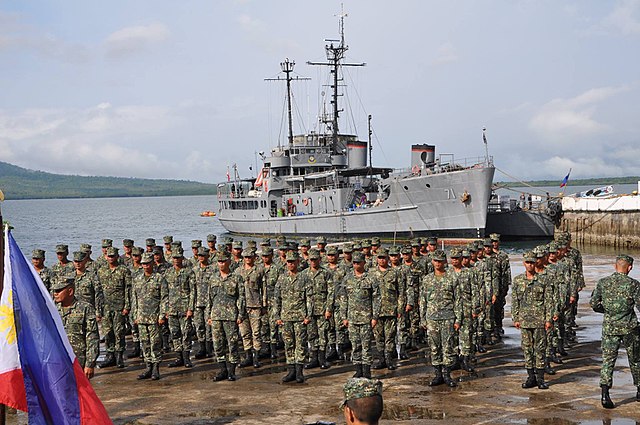
-Naval Base Heracleo Alano (Cavite City, Luzon): Headquarters
-Naval Base Camilo Osias (San Vicente) at Santa Ana, Cagayan, Luzon
-Naval Base Subic (Zambales, Luzon)
-Naval Base Rafael Ramos (Mactan) at Lapu-Lapu City, Cebu in the Visayas
-Naval Station Jose Andrada (Fort San Antonio Abad) as Manila HQ
-Naval Station Jose Francisco (NAS Bonifacio) in Bonifacio Global City
-Naval Station Heracleo Alano (Sangley Point) in Cavite, Luzon, Naval Air Group HQ
-Naval Station Pascual Ledesma (Fort San Felipe)
-Naval Station Ernesto Ogbinar (Poro Point) in San Fernando, La Union, Northern Luzon HQ
-Naval Station Leovigildo Gantioqui (San Miguel) in San Antonio, Zambales, Luzon, Training/Doctrine HQ
-Naval Station Narciso Del Rosario (Balabac) in Palawan
-Naval Station Emilio Liwanag (Pag-asa) in the Kalayaan Islands, Palawan
-Naval Station Apolinario Jalandoon (Puerto Princesa), Palawan
-Naval Station Carlito Cunanan (Ulugan) Puerto Princesa, Palawan
-Naval Station Julhasan Arasain (Legazpi) in Albay, Southern Luzon HQ
-Naval Station Alfonso Palencia (Guimaras) in the Visayas
-Naval Station Dioscoro Papa (Tacloban), Leyte, Visayas
-Naval Station Felix Apolinario (Davao) Eastern Mindanao HQ
-Naval Station Romulo Espaldon (Zamboanga) Western Mindanao HQ
-Naval Station Rio Hondo (Zamboanga City) Mindanao
-Naval Station Juan Magluyan (NOB Batu-Batu) Tawi-Tawi, Mindanao.
The Philippines Navy today and future plans:
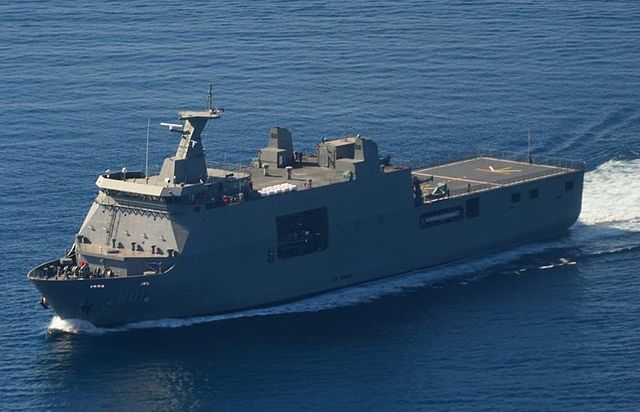
BRP Tarlac (LPD)
The Philippine Navy as of today in October 2022 comprises 82 combat vessels plus 14 auxiliaries:
2 Landing Platform Docks (+2 in completion)
2 Frigates (class)
1 Corvettes (+3 in completion, class)
7 Offshore patrol vessels (+6 in construction)
3 Littoral patrol vessels (+5 in construction)
27 Coastal patrol craft
18 Fast attack craft (+9 in construction)
4 Landing ship, tank and Logistics support vessels
20 Landing craft utility (LCU)
18 Auxiliary ships
5 Miscellaneous vessels
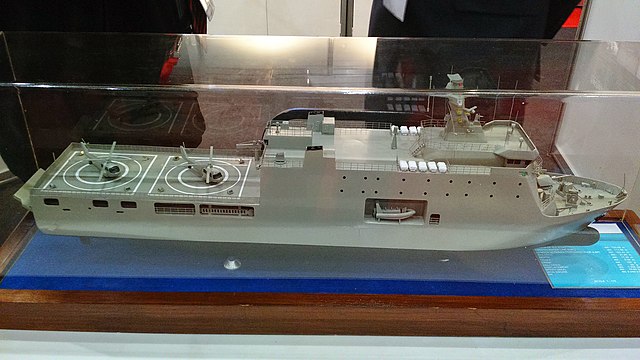
The largest vessels in the Navy today are the two Tarlac class LPDs, built 2015–2017. Two service support vessels (SSVs), smaller and still able to move a battalion, with helipad, SAR platform, hospital facilities were announced in 2013, with PT PAL of Indonesia winner. With two LPDs and these two LSVs, the Philippines would have the capabilities to land four complete batallions.
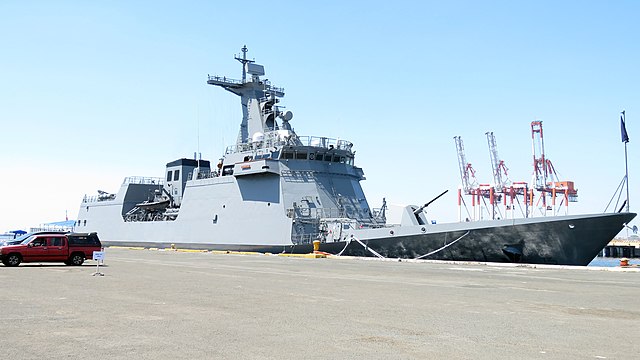
As for surface combatants, after a first one, the Philippines announced the acquisition of four Pohang-class Corvette from South Korea, aftr the acquisition of decomm. ROKS Andong, delivered in early 2022.
There is no current replacement plan for the actual Frigates of the Jose Rizal-class frigate built in South Korea in 2018–2020 (Rizal, Antonio Luna).
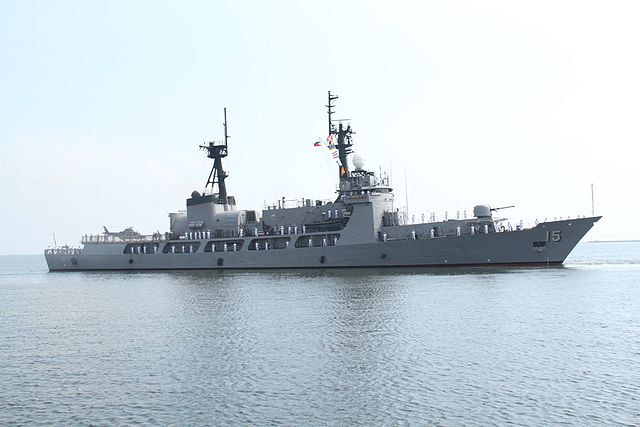
The larger three Del Pilar-class offshore patrol vessel, former US Coast Guard Hamilton-class high-endurance cutter were acquired in 2011-2016 and now are scheduled for replacement in the late 2030s, being built in 1965. In between, they were indeed upgrades already after recommission, and further upgrades regarding navigation, propulsion, communication, surveillance, and weapons systems are planned, a new torpedo weapon system and Hull Mounted Sonar were mounted in 2020 while later this year a 3D model was showing the entire wiring and electronics upgrade scheme.
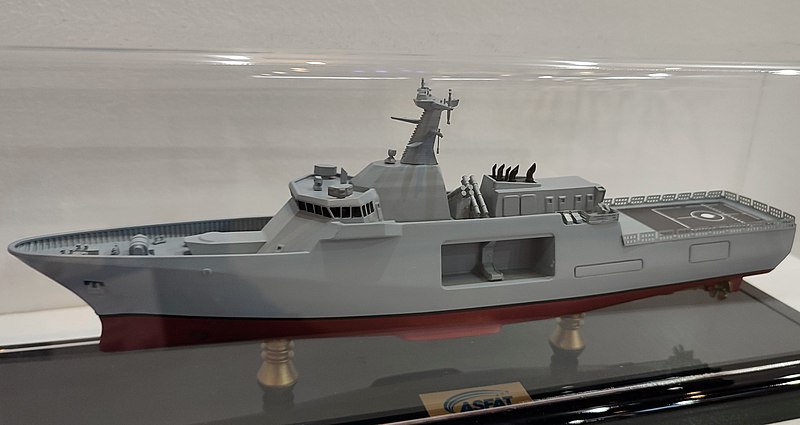
Actions post-cold war includes the Battle of Zamboanga City in 2013, Battle of Marawi in 2017. The next year there was a proposal to have it made fully independent, never passed.
The Coastal Defense Regiment was created in August 2020, as part of the Philippine Navy’s Active Archipelagic Defense Strategy for anti-access and area denial operations, EEZ protection of the extended continental shelf and Sea Lines of Communications with plans to acquire the Shore Based Anti Ship Missile System, (with the BrahMos) expected fully commissioned by 2026.
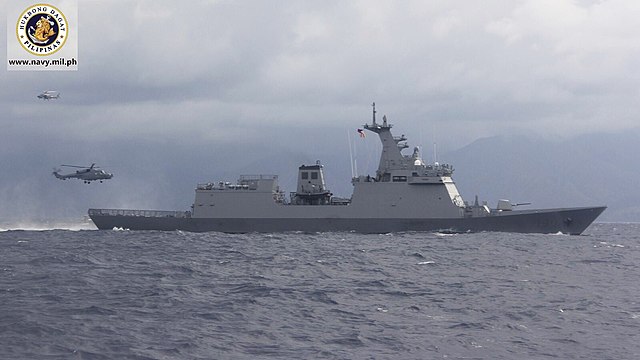
BRP Jose Rizal FF-150
 Destroyer Rajah Soliman (1961)
Destroyer Rajah Soliman (1961)
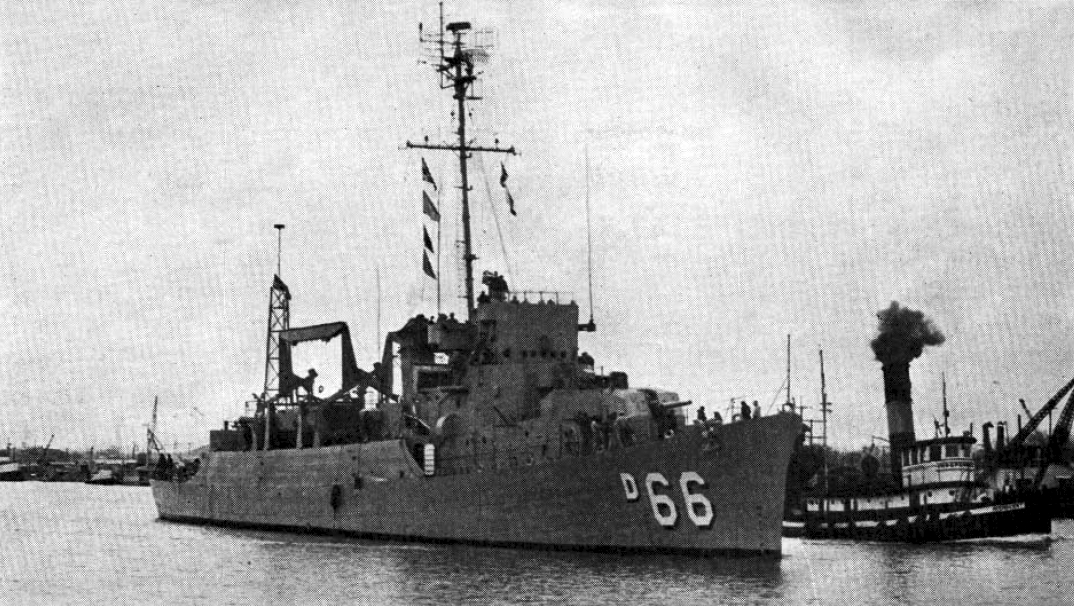
Former Buckley class (TE) USS Bowers D66, new pennant PF, built in Bethlehem, San Francisco, launched 31.10.1943 and transferred on 31.10.1960. She was former high speed transport, transferred under MDAP She foundered on 29 June 1964 in a Typhoon, but was raised but not repaired and BU on 3 December 1964.
 Destroyer Rajah Lankadula (1976)
Destroyer Rajah Lankadula (1976)
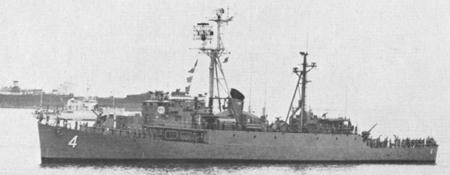
A FMR type escort destroyer, built at Brown SB in Houston, converted as radar picket. She was transferred to the south vietnamese navy on 6 February 1971, acquired by the Philippines in 1975, pennant PF4, renamed Rajah Lankadula. She survived until 1995, used as floating HQ.
 Andres Bonifacio class Frigates (1946)
Andres Bonifacio class Frigates (1946)
Andres Bonifacio, Georgio del Pilar, Diego Silang, Francisco Dagohoy

PF7 Andres Bonfiacio
These Barnegat class fleet (seaplane) tenders served in WW2 before ending as surplus in 1946 and being transferred to the US Coast Guard on loan as MSAP until 1947 and later on permanent loan as WHEC Casco class cutters. Next, they were transferred via MDAP to the South Vietnamese Navy to bolster it after the gradual retirement of the USN in 1971-72. After the SVA fell, they were retransferred to the Philippines Navy in 1976, but some arrived in 1979. Yakutat and Cook Inlet were also transferred, but as spare parts reserve, not commissioned. These vessels stayed active until the decommission from 1986
 Datu Kalantian class Frigates (1976)
Datu Kalantian class Frigates (1976)
Datu Kalantian, Rajah Humabon, I, II
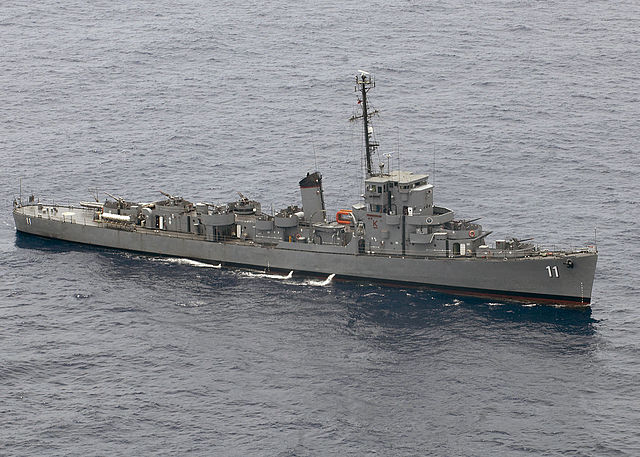
These USN destroyer escort of the Cannon (DET) class were transferred in 1976 and the other three in 1978, the last two kept for spares. The latter changed flag thrice already. They served in the JMSDF already for years as Asahi, Atsuhi, and Kang Won, all modernized in South Korea after being towed there by October 1978. Datu was lost in the cyclone “clara” in 1941, stricken in 1984 and her sister ship served until 1995 (circa), BU afterwards.
 Pagasa class Corvettes (1948)
Pagasa class Corvettes (1948)
Pagasa, Samar, Magat Samaat
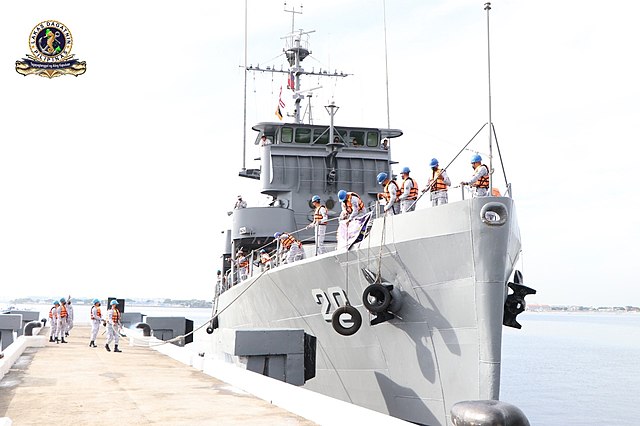
The following corvettes are merely ocean minesweepers converted as such, of WW2 stock: ex-Admirable class, ex PCE type or 185ft and AUK type. The Pagasa class comprised three ships,which had their minesweeping gear removed after transfer in 1948. Pagast served also as presidential yacht. She had her stern rebuit. and served also as command vessel. Samar was rearmed with a single 76mm, 2×2 40 mm and four 20mm AA guns, later used for survey. The last was transferred from South Vietnam in the late 1970s after an already long career and in poor shape. She was the only one still extant in the 1990s, the other were scrapped in between.
 Cebu class Corvettes (1948)
Cebu class Corvettes (1948)
Miguel Malvar, Sultan Kudarat, Datu Marikudo, Cebu, Negros Occidental, Leyte, Pangasinan, Iloilo
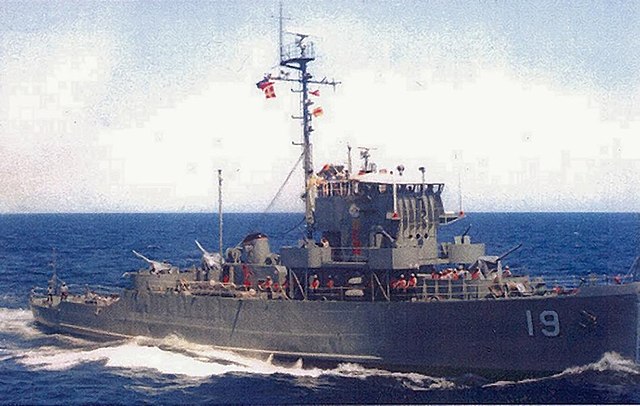
The class comprised eight ships, all ex-PCE 185fr types, the first transferred without their minesweeping gearfrom July 1948. They had a single 3-in/50 and three to six 40mm Bofors, four 20mm AA guns, three single 324mm ASW TTs, DCR, DCT and Hedgehog, being used for ASW. Leyte ran aground in 1976. The las three were transferred in the 1970s from S Vietnam. All discarded in the late 1970s.
 Rizal class Corvettes (1965)
Rizal class Corvettes (1965)
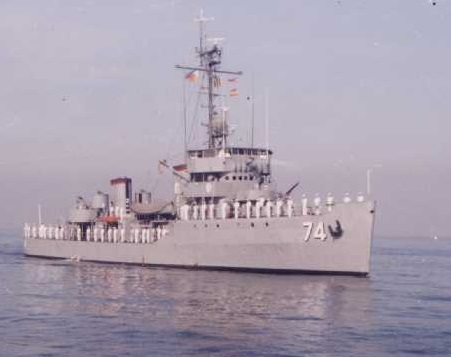
 Cutabato class LST (1948)
Cutabato class LST (1948)
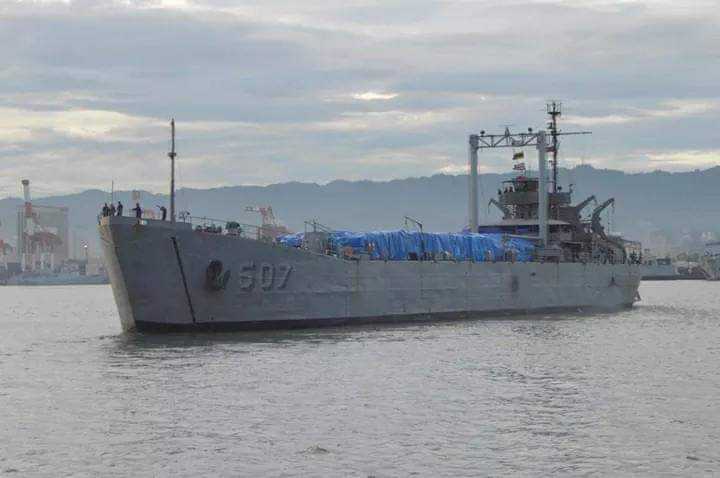
In total, 23 built (other sources claimed 27). They were all transferred from 1948 onwards in several batches. All were named after rivers and straits. Several had undergone a comprehensive refit, including structural changes and new electrical wiring, engine overhaul, etc. The other were transferred from South Korea and South Vietnam in the 1970s. The last Vietnamese vessels were acquired at scrap value, the last arriving in 1976. They needed two years to be in relative shape and some were refitted in Japan, but two were scrapped in 1978, Cutabato and Maquindanao. By the late 1990s they were in poor shape and by 1995 only five remained serviceable.
 Isabela class LSM (1961)
Isabela class LSM (1961)
Isabela, Batanes, Oriental Mindor, Batanes (ii), Western Samar
These were transferred in 1961-62. The first, BAP Batanese ran aground and was replaced by LSM 75 from S Vietnam in 1975 as well as LSM 110 for spares the same year. All were stricken in the early 1990s.
 Bacolod City class LSL (1991)
Bacolod City class LSL (1991)
Bacolod City, Cayagan de Oro City
These were among the rare Philippines Vessels built on purpose and not transferred from WW2 stocks: The Bacolod city class landing ships were designed to fit logistic purpose inside the amphibious force, ordered to Trinidad Marine on 3 April 1993 to the US Frank S Besson class design currently produced for the US Army. Typical Ro-Ro designs with a 10n500 sq feet cargo deck. The military load was 2280 tons, and 990 were usable for amphibious operations. It cold also accomodate 150 fully equipped Philipino Marines. They were fitted with 250 bhp bow thruster for agility at low speeds, and had an astern helipad. Approved in 1990, they were started in 1991 and commissioned in 1993-94, so a bit off-topic here.
Specs:
4265 tonnes full load, payload 2280 tons
Dimensions 83.1 x 18.3 x 3.7m (282ft 8in x 60ft x 12ft)
2 shafts GM EMD 16-645E2 Diesels, 39,000 bhp, 11.6 kts
Range 6000 nm/11 knots
No armament, crew 30 including 6 officers
 Camarines Sur class LSSL 1 (1975)
Camarines Sur class LSSL 1 (1975)
Camarine Sur, Sulu, La Union
WW2 LSSL 1 type fire support landing ships. La Union was the former LSSL-9, transferred to France in 1951 as Hallebarde (L9023), then Japan in 1956-64, to South Vietnam after return in 1965 for spared and sold to the Philippines in 1975 practically at scrap value. The other three had similar origin, also transferred in 1975. They were armed with a single 76mm, four 40mm AA, four 20mm AA and four MGs. All were stricken in 1991.
 Marinduque class LSIL (1975)
Marinduque class LSIL (1975)
Marinduque, Seosorgon, Camarines Norte, Masiamis Occidental
These Infantry Landing ships had similar origins that the ones above. They were all first transferred to France after a WW2 carrer, then to South Vietnam until the fall of Saigon. They were reaquired by the Philippines in 1975, LSIL 476 were kept for spares. The latter was scrapped in 1979 and the others in 1980.
 Filipino Landing Crafts
Filipino Landing Crafts
56 LCM(3), 50 LCM(6), 7 LCVP, 3 LCU
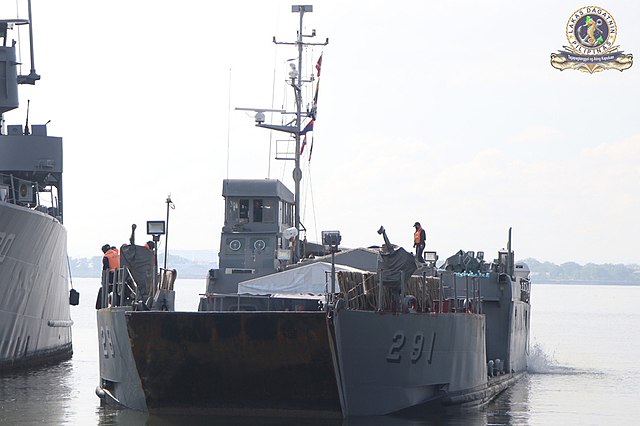
BRP Subanon
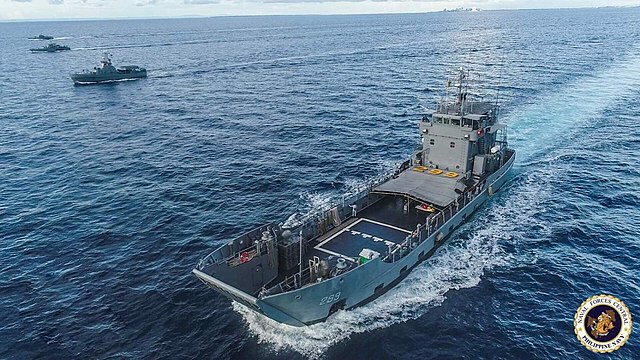
BRP Batak LC-299
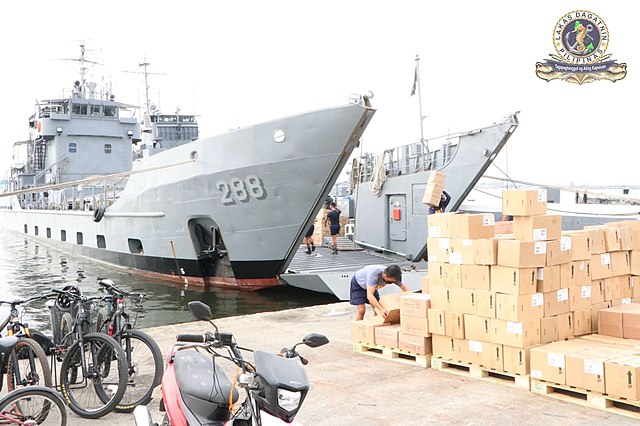
BRP Waray, all three are more recent and replaced the cold war amphibious vessels.
The Philipines Navy acquired the following during the cold war:
-50 LCM(6) in 1955(1), 1971(13) and the last 36 in 1973, probably ex-South Vietnamese
-7 LCVP in 1955, 1965, 1971, 1973.
-11 LCM(8) in 1973-75
-3 LCU 1466 types transferred from Japan on 17 Nobember 1975.
Presumably all stricken in the 1990s.
 Camarines Sur class submarine-hunters (1947)
Camarines Sur class submarine-hunters (1947)
Camarines Sur, Bohol, Zamboanga del Sur, Batangas, Nuevo Ecija, Negros Oriental, Capiz, Nueva Viscaya, Negros Oriental(ii)
Seven PCE 173 feet types of WW2 transferred in 1948, 58 and 1968. Camarines was stricken in 1953, Negors Oriental sunk in an Typhoon off Guam in 1962, stricken 1963. The others were stricken in 1969, 1979 PC 1171 was a Cambodian vessel which fled to the Philippines and was integrated as Negros Oriental. The last were discarded in 1989.
 Tarlac class submarine chasers (1948)
Tarlac class submarine chasers (1948)
Tarlac, Laguna
These were the ex PG-11 and and LG 12, built 1942, transferred in January 1948. Both were scrapped in 1969, armed with a 76 mm, 40 m and 20 mm AA guns.
 Cagayan class submarine chasers (1946)
Cagayan class submarine chasers (1946)
Cayagan, Mountain Province, Ilocus Sur, Alert, Syrigao, Isabella, Cavite, Ilocus Norte
These were small SC 110 ft type vessels, built in WW2 and transferred in 1946-48. Ilocus norte was renamed Malampay Sound. Three were discarded in 1956 and the other followed suite in 1956-57.
Next Update: Patrol Boats and minesweepers of the cold war Philippines Navy.
Gallery

BRP Miguel Malvar PS-19
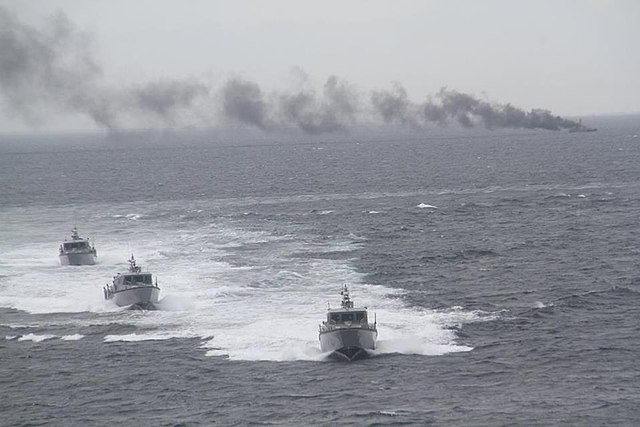
MPAC Mk.3 at a live fire exercize in 2018

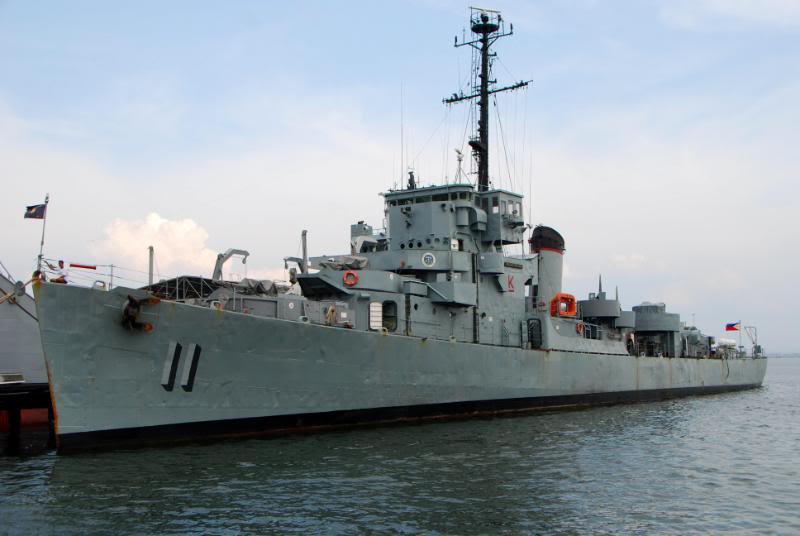
BRP Rajah Humabon
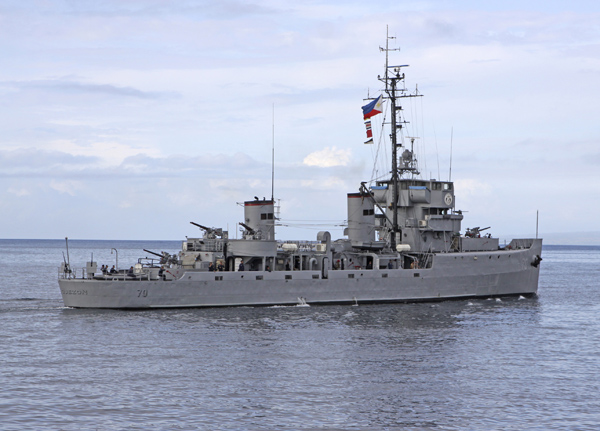
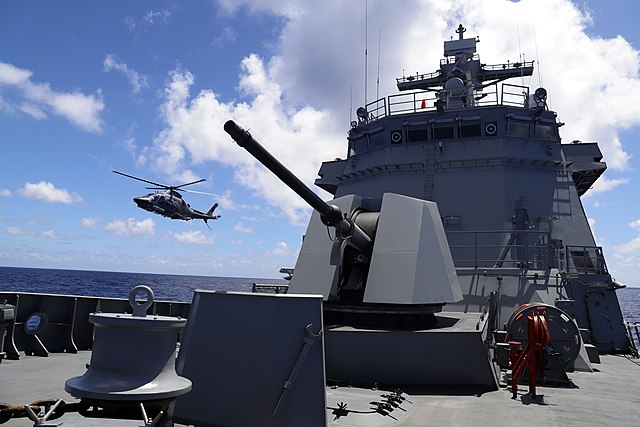
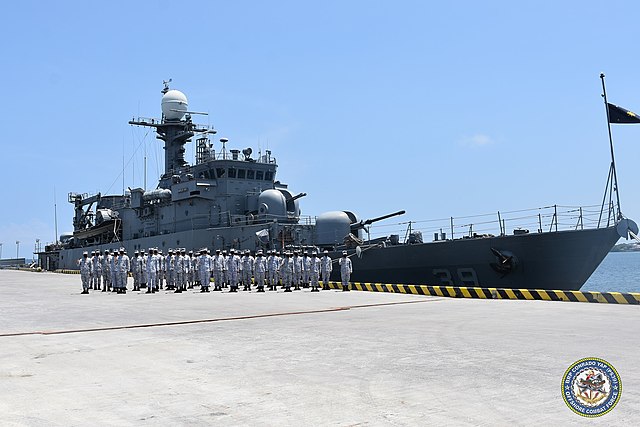
BRP Conrado, Yap-2
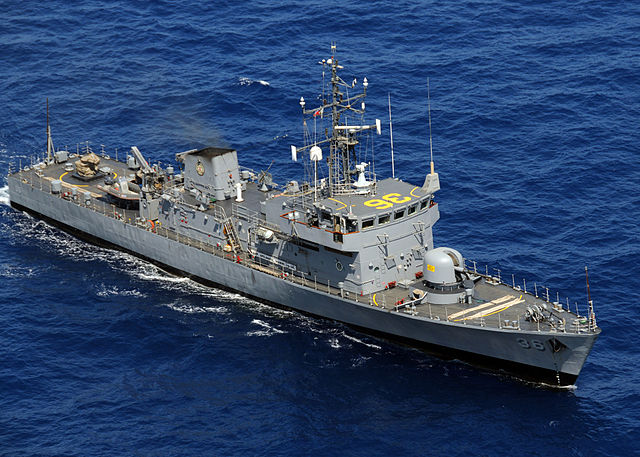
PS-36 Apolinario Namibi off Balikanta 2010
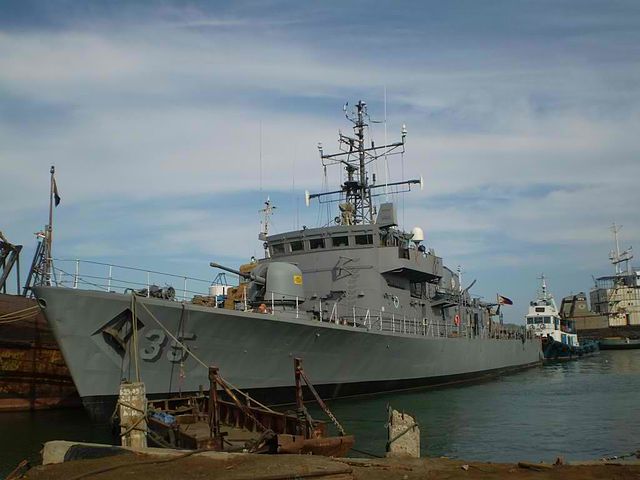
BRP Jacinto

BRP Mayagan AS-71
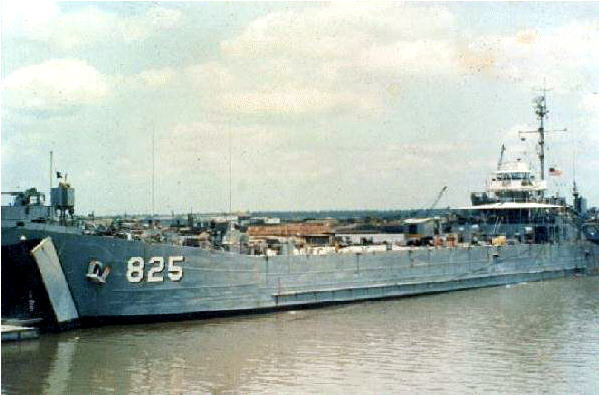
LST-825

BRP Benguet, LST-507
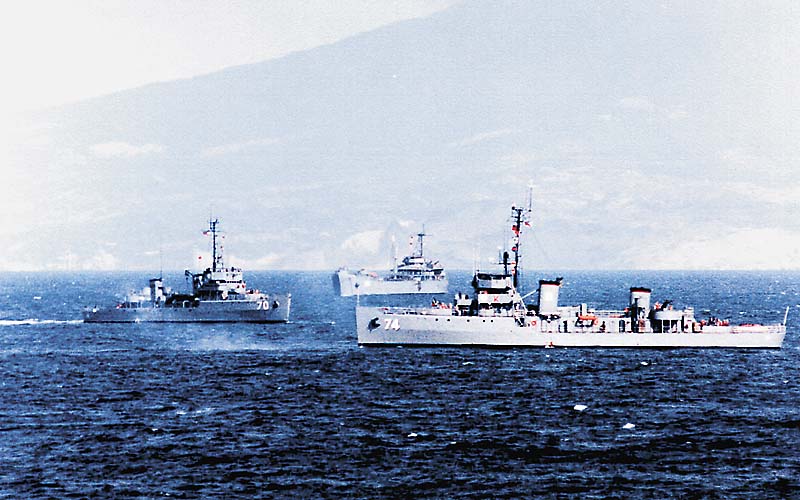
BRP Rizal and Quezon
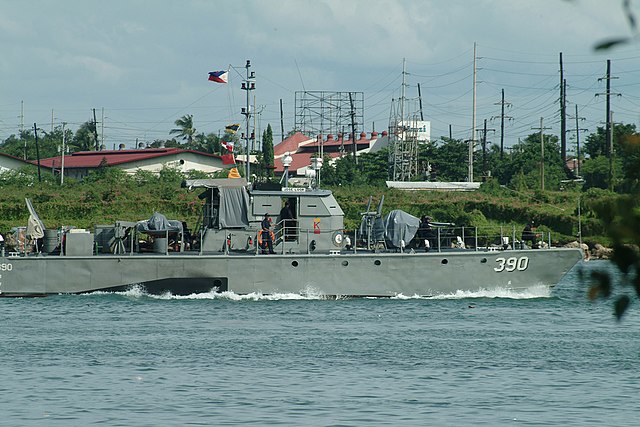
BRP Jose loor

BRP Batak LC-299
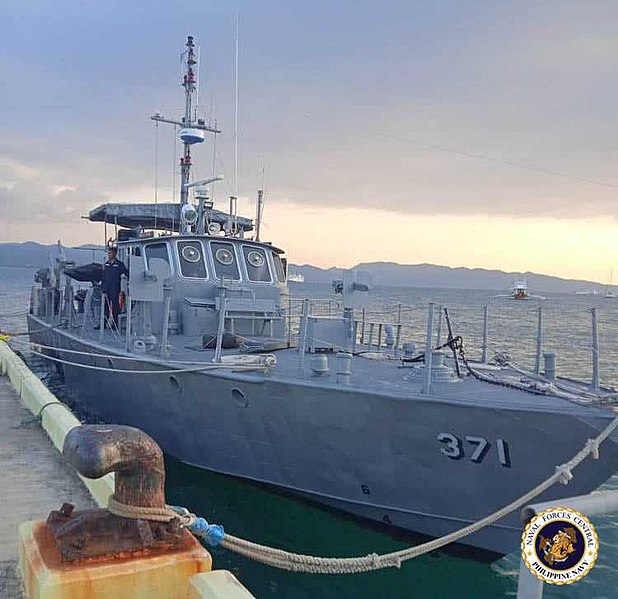
BRP Enrique Jurado PC-371
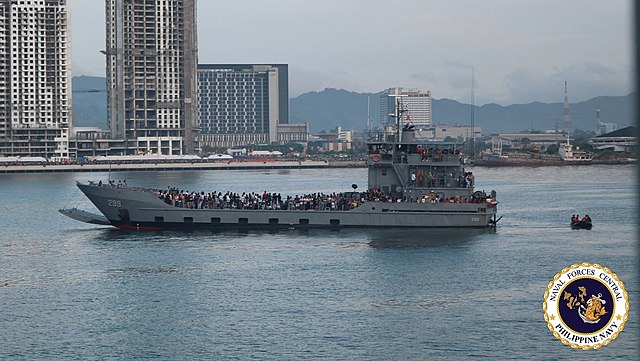
BRP Batak at Sinulog 2019
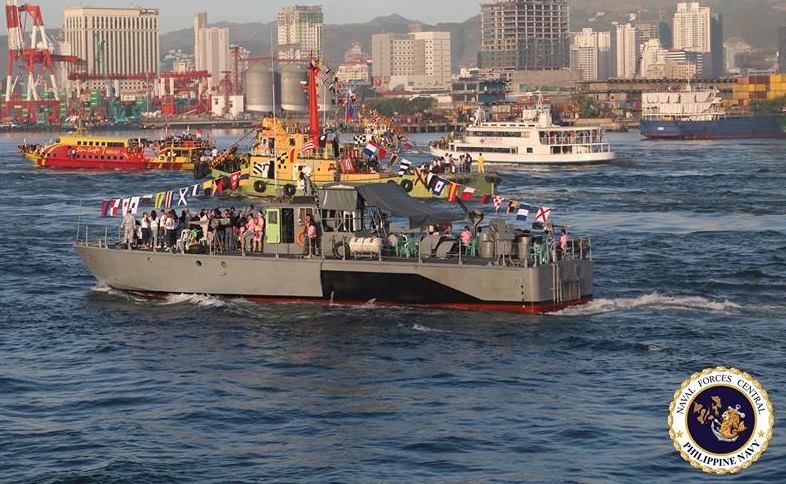
BRP Alfredo Peckson at Sinulog 2019
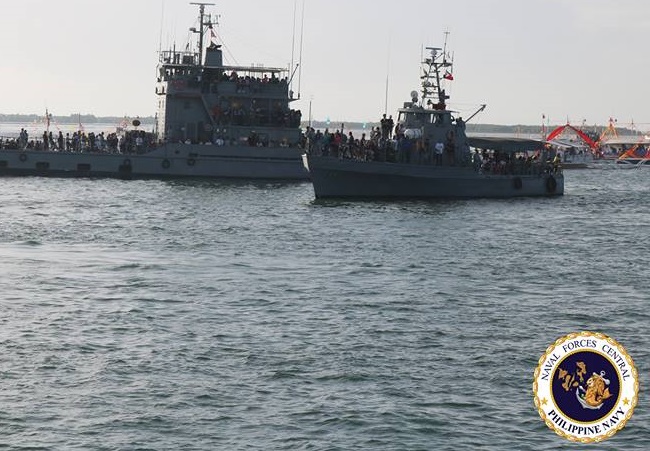
BRP Abraham Campo at Sinulog 2019
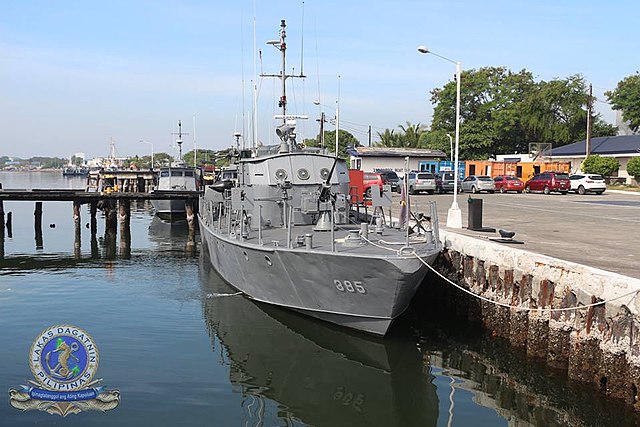
BRP Felix Apolinario 2018

BRP Waray
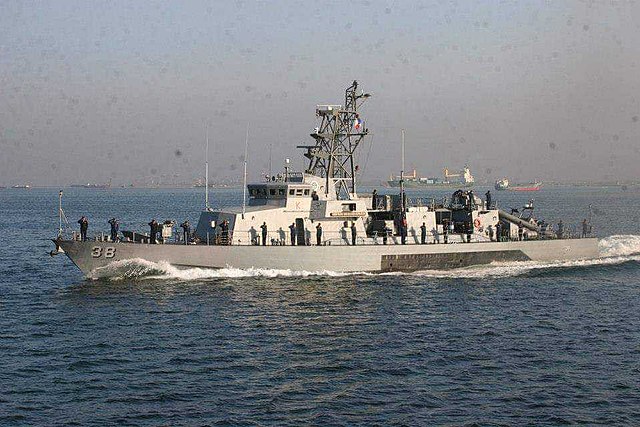
BRP General mariano Alvarez, PS-38
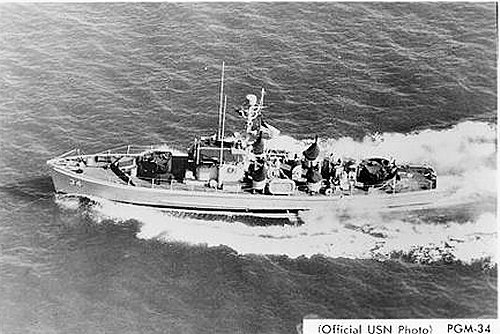
BRP Sulu PG-49

Type 996Y patrol boats
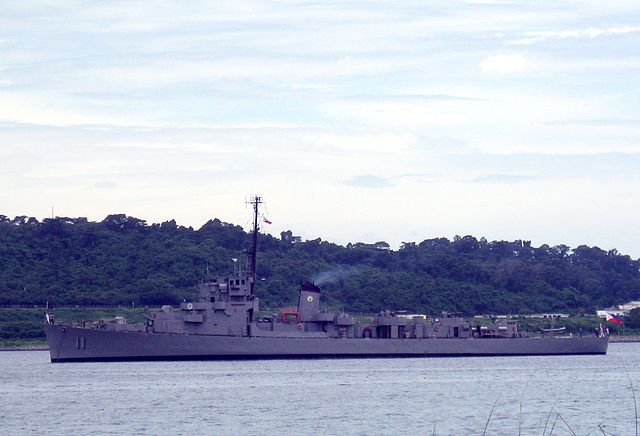
PF-11 (Rajah Lankadula) in Subic Bay
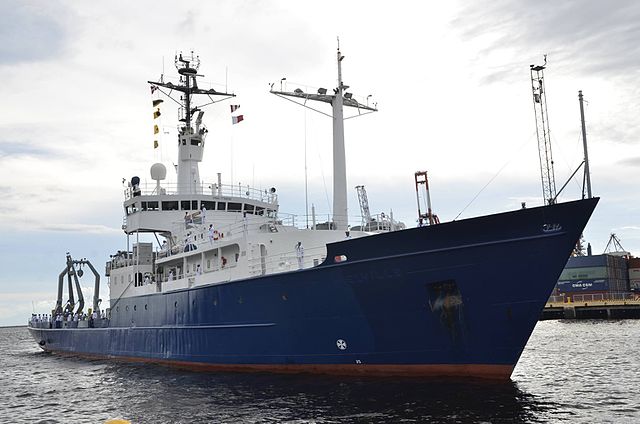
BRP Gregorio Velasquez (AGR-702)
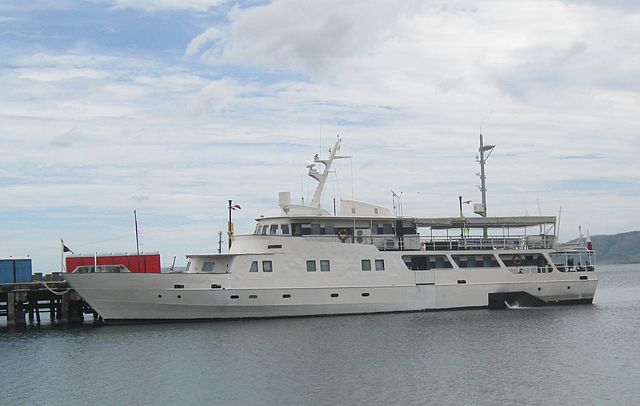
BRP Fort Abad
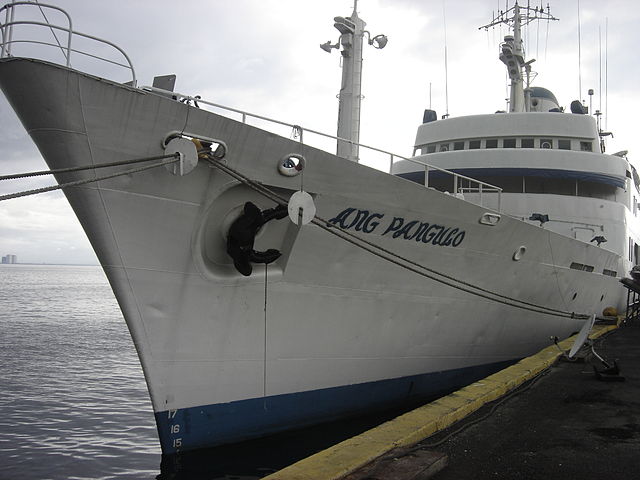
BRP Ang Pangulo AT-25
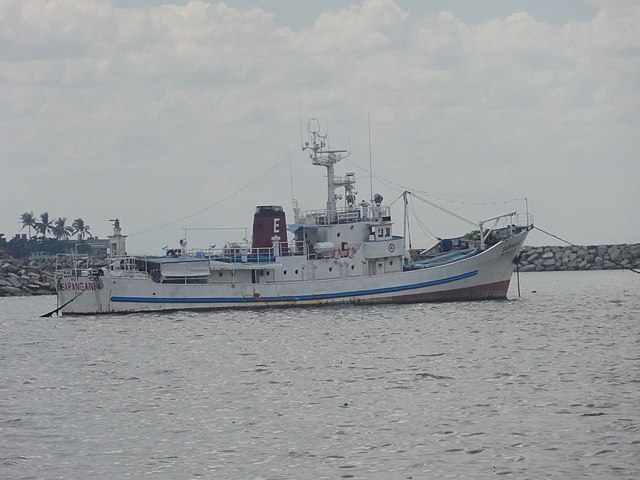
mv sarangani in Manila bay
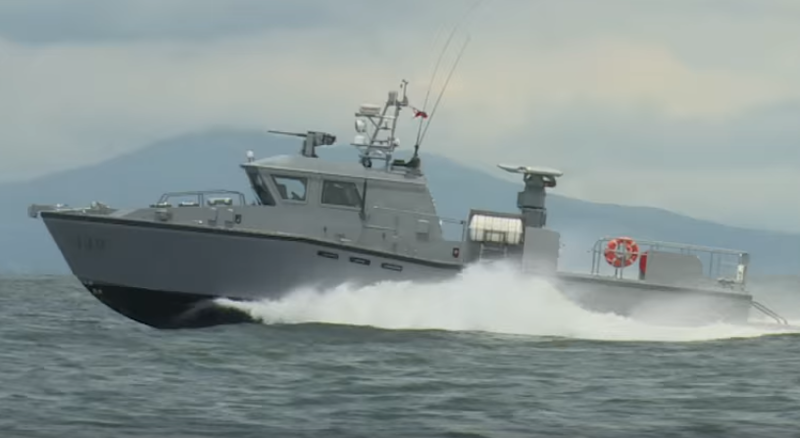
MPAC MK III CPV
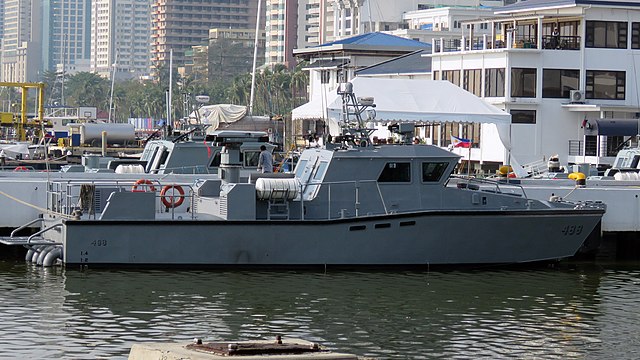
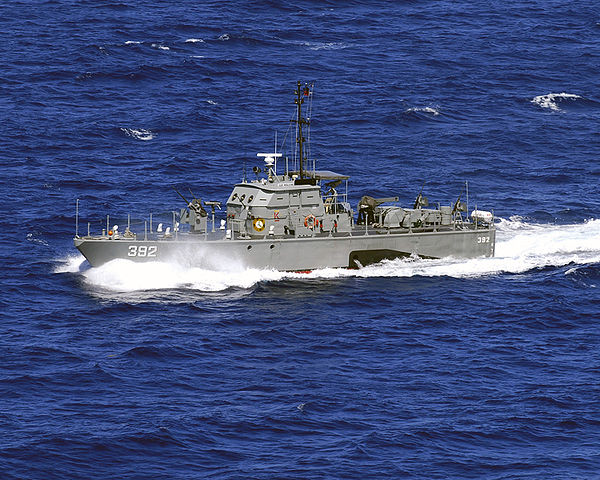
BRP Juan Magluyan, PG-392
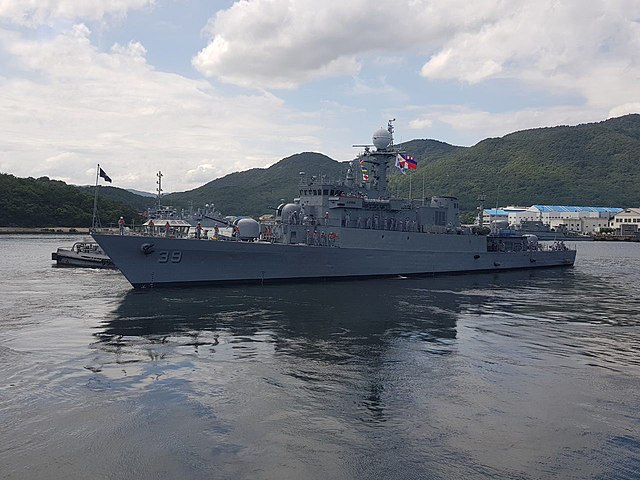
BRP Conrado Yap, PS-39
Sources
Links
https://www.nationalww2museum.org/war/articles/july-4-1946-philippines-independence
https://www.navy.mil.ph/
https://web.archive.org/web/20111017080704/http://www.navy.mil.ph/organization.php
https://web.archive.org/web/20100217101436/http://www.navy.mil.ph/history.htm
https://web.archive.org/web/20080403021636/http://www.navy.mil.ph/
https://www.navypedia.org/ships/philippines/phil_index.htm
https://en.wikipedia.org/wiki/Philippine_Navy
https://en.wikipedia.org/wiki/Military_history_of_the_Philippines
https://commons.wikimedia.org/wiki/Category:Navy_of_the_Philippines
https://www.reuters.com/article/us-philippines-southchinasea/philippines-to-get-frigates-gunboats-helicopters-as-tension-simmers-idUSKBN0JV0N720141217
https://web.archive.org/web/20180322015434/https://www.rappler.com/world/regions/asia-pacific/139392-timeline-west-philippine-sea-dispute
https://www.janes.com/defence-news/news-detail/philippine-navy-decommissions-two-legacy-corvettes-two-fast-attack-craft
Books
Philippine Navy. (1998). Tides of change. Manila: Philippine Navy.
Philippine Navy. (2007). The Philippine Navy Strategic Sail Plan 2020 Book 1 2007.
Philippine Navy. (2014). “Rough Deck Log: 2014 Philippine Navy Anniversary Issue, to The Shores of Pusan (1950–1953) Mark R Condeno

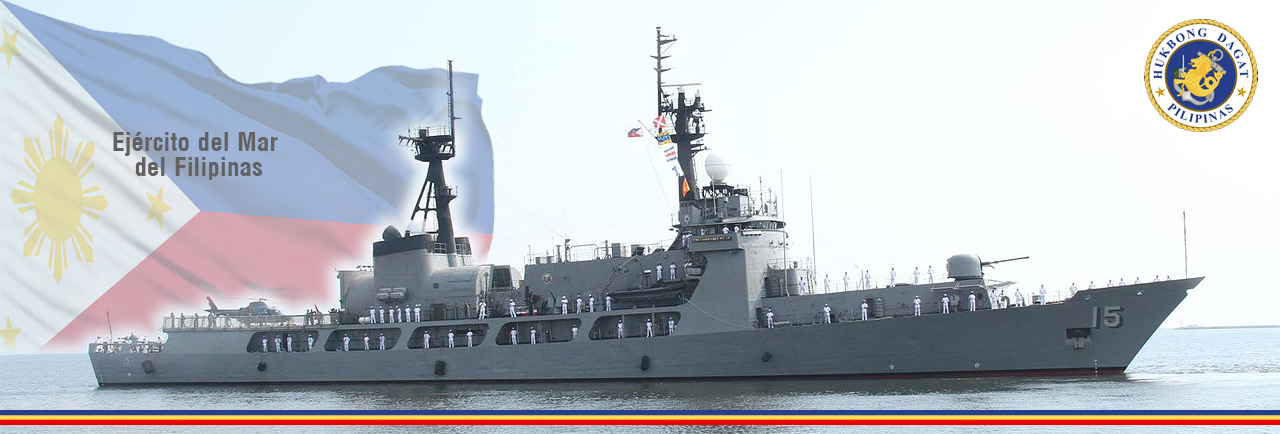
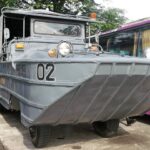
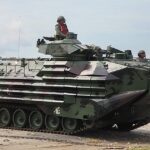
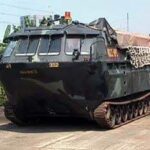
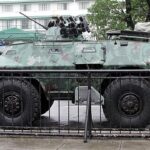
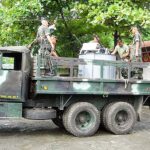
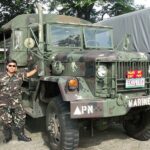
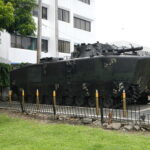
 Latest Facebook Entry -
Latest Facebook Entry -  X(Tweeter) Naval Encyclopedia's deck archive
X(Tweeter) Naval Encyclopedia's deck archive Instagram (@navalencyc)
Instagram (@navalencyc)





 French Navy
French Navy Royal Navy
Royal Navy Russian Navy
Russian Navy Armada Espanola
Armada Espanola Austrian Navy
Austrian Navy K.u.K. Kriegsmarine
K.u.K. Kriegsmarine Dansk Marine
Dansk Marine Nautiko Hellenon
Nautiko Hellenon Koninklije Marine 1870
Koninklije Marine 1870 Marinha do Brasil
Marinha do Brasil Osmanlı Donanması
Osmanlı Donanması Marina Do Peru
Marina Do Peru Marinha do Portugal
Marinha do Portugal Regia Marina 1870
Regia Marina 1870 Nihhon Kaigun 1870
Nihhon Kaigun 1870 Preußische Marine 1870
Preußische Marine 1870 Russkiy Flot 1870
Russkiy Flot 1870 Svenska marinen
Svenska marinen Søværnet
Søværnet Union Navy
Union Navy Confederate Navy
Confederate Navy Armada de Argentina
Armada de Argentina Imperial Chinese Navy
Imperial Chinese Navy Marinha do Portugal
Marinha do Portugal Mexico
Mexico Kaiserliche Marine
Kaiserliche Marine 1898 US Navy
1898 US Navy Sovietskiy Flot
Sovietskiy Flot Royal Canadian Navy
Royal Canadian Navy Royal Australian Navy
Royal Australian Navy RNZN Fleet
RNZN Fleet Chinese Navy 1937
Chinese Navy 1937 Kriegsmarine
Kriegsmarine Chilean Navy
Chilean Navy Danish Navy
Danish Navy Finnish Navy
Finnish Navy Hellenic Navy
Hellenic Navy Polish Navy
Polish Navy Romanian Navy
Romanian Navy Turkish Navy
Turkish Navy Royal Yugoslav Navy
Royal Yugoslav Navy Royal Thai Navy
Royal Thai Navy Minor Navies
Minor Navies Albania
Albania Austria
Austria Belgium
Belgium Columbia
Columbia Costa Rica
Costa Rica Cuba
Cuba Czechoslovakia
Czechoslovakia Dominican Republic
Dominican Republic Haiti
Haiti Hungary
Hungary Honduras
Honduras Estonia
Estonia Iceland
Iceland Eire
Eire Equador
Equador Iran
Iran Iraq
Iraq Latvia
Latvia Liberia
Liberia Lithuania
Lithuania Mandchukuo
Mandchukuo Morocco
Morocco Nicaragua
Nicaragua Persia
Persia San Salvador
San Salvador Sarawak
Sarawak Uruguay
Uruguay Venezuela
Venezuela Zanzibar
Zanzibar Warsaw Pact Navies
Warsaw Pact Navies Bulgaria
Bulgaria Hungary
Hungary

 Bundesmarine
Bundesmarine Dutch Navy
Dutch Navy Hellenic Navy
Hellenic Navy Marina Militare
Marina Militare Yugoslav Navy
Yugoslav Navy Chinese Navy
Chinese Navy Indian Navy
Indian Navy Indonesian Navy
Indonesian Navy JMSDF
JMSDF North Korean Navy
North Korean Navy Pakistani Navy
Pakistani Navy Philippines Navy
Philippines Navy ROKN
ROKN Rep. of Singapore Navy
Rep. of Singapore Navy Taiwanese Navy
Taiwanese Navy IDF Navy
IDF Navy Saudi Navy
Saudi Navy Royal New Zealand Navy
Royal New Zealand Navy Egyptian Navy
Egyptian Navy South African Navy
South African Navy






























 Ukrainian Navy
Ukrainian Navy dbodesign
dbodesign